Jefferson Vineyards Wine Blog
A Wine Transformed - Petit Verdot
In 1984 our vineyard and its vines were just a few years old, and even Virginia as a growing region was itself budding and new. Yet, taken by the potential of our land, we were fast at work developing the wine region to come. Our winemaker in 1984, Gabriele Rausse, who joined us after playing a critical role establishing Barboursville Vineyards, busied himself grafting new vines - many of which were the same varietals Thomas Jefferson himself has grown centuries prior. Among these experimental grafts was Petit Verdot.
Petit Verdot, pronounced “peh-tee vur-doe”, is a bold red wine. Hailing from France’s renowned Bordeaux region, it is one of the five grapes that typically compose the equally legendary Bordeaux blend. A dark and velvety hue in the glass, Petit Verdot is bold and distinguished. Deep fruit aromas like plum, blueberry, and dark cherry on the nose, with herbal flavors on the palate and warm tannins on the finish define this elegant wine. Historically, however, Petit Verdot was rarely showcased on its own.
The name “Petit Verdot” translates loosely to ‘little green one’, due mostly to its late ripening cadence, meaning the grapes were frequently still somewhat green by harvest’s time [1]. Accordingly, it was used in small amounts in blends, added to give tannic structure to the wine, and lend interesting tasting notes like violet or sage [2]. But no longer is Petit Verdot confined to a supporting role.
In 2001, Jefferson Vineyards was among the first Virginian vineyards to bottle a single varietal Petit Verdot. Two decades later, single varietal Petit Verdot maintains a place amongst our portfolio’s darlings. We showcase Petit Verdot as a single varietal wine, celebrated its strengths as a blending grape, and have used it as the foundation for many of our beloved Meritage blends (a new world take on the old world Bordeaux blend). Each iteration highlights the strength of this special varietal and we are humbled by the accolades we have collected for our Petit Verdot over the years.
How apt a varietal for October, a transitional season between Fall and Winter, then a varietal which itself has been transformed. Deep, velvety, and warm, Petit Verdot no longer is found listed only in the blend’s composition. It, as a single varietal wine, has shaped our trajectory for decades and has come to be celebrated as defining Virginian wine.
This October, we celebrate a grape that, though it is one of the last we harvested, is well worth the wait. Enjoy our oldest Petit Verdot as a single varietal, Petit Verdot 2016, with a bouquet of vanilla and caramel on the nose, coffee and berry flavors on the palate, and a warm, lingering finish with hints of cherry. Our 2018 Petit Verdot vintage opens with dried red fruit and hints of tobacco on the nose, the palate is smooth and integrated with vibrant fruit and black tea flavors, before a bright acidic finish with raspberry and sandy tannins. Or, enjoy a newer vintage - our 2019 Petit Verdot has dried fruit and oak on the nose, with a vibrant palate of red berry flavors before a bright, lingering finish filled with raspberry notes and warm tannins Alternatively, our 2017 Petit Verdot Reserve is made from only the best fruit. This lovely wine opens with aromas of vanilla and cedar, the palate displays berry, plum, and raisin flavors before tart cherry notes in the finish. Experience each (and more) in our Featured Wines Shop.
[1] "Guide to Petit Verdot Red Wine". Wine Folly, Wine Folly, 10 Mar. 2016, winefolly.com/deep-dive/guide-to-petit-verdot-red-wine.
[2] Ibid.
Saving the Best for Last
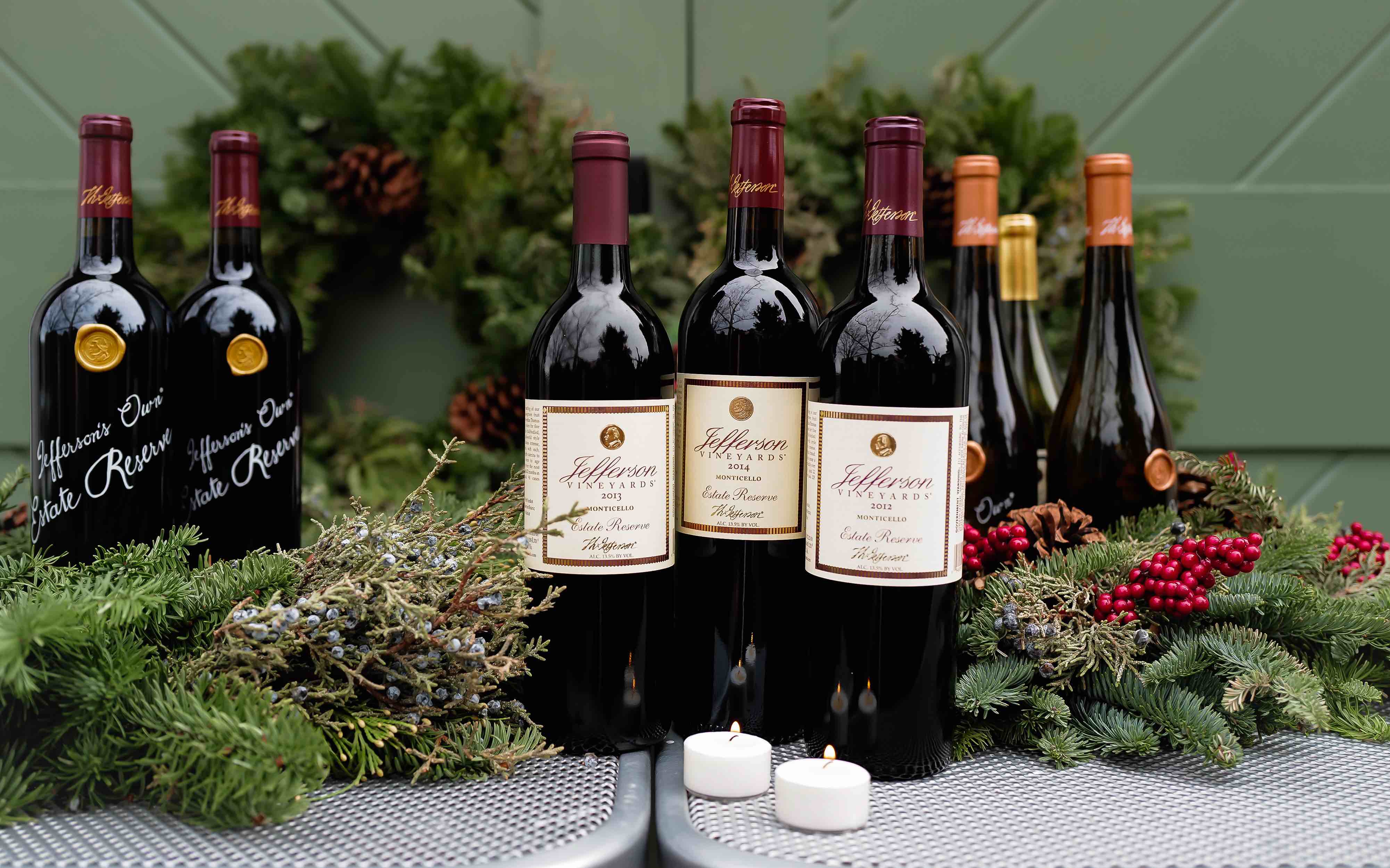
As cooler temperatures settle in and begin warming up indoors, we’ve saved the best for last.
We at Jefferson Vineyards are celebrating our 40th Anniversary and looked back upon the last 4 decades. A viticultural vision conceived by a founding father and his Italian merchant friend; our land first grew grapes centuries ago. In these rolling hills nestled besides Virginia’s mountains Jefferson and Italian Viticulturalist, Phillip Mazzei, recognized terrain and climates capable of growing fine wines. Centuries later, an American diplomat enchanted by European wines had a similar vision. Founded first to bring friends, family, and guests from around the globe together around a bottle of wine. Shirley and Stanley Woodward established our vineyard in 1981. With the help of Gabriele Rausse, who had come to Virginia from Italy to help institute Barboursville Vineyards, we planted our first vines. Few other Virginian wineries existed at the time and our success followed ceaseless cycles of trial and error, resilience, and impassioned persistence.
In looking back, we found stories of resilience, of evolution, and of steadfast commitment to our core. Passed from generation to generation, Jefferson Vineyard’s story unfolded in the hands of family and friends. With it, our wine and wine programs too have evolved. The best of which are our Estate Reserve Wines into whose creation and production we have infused more thought, more consideration with each year, especially over the last four years.
Our winemaking team dedicates themselves fully to each wine. They could tell you everything about each barrel in our winery and every wine inside. Our Estate Reserve wines are the best of our already best efforts. Made from our vineyard’s best top fruit, Estate Reserve wines are given extra care from the vines to the bottle.
Estate Reserve wines come from our vineyards’ best finest blocks. Though we can’t control the weather or what pests choose to visit the vines, we take every precaution to protect our fruit and push it to optimal ripeness before harvesting. We added fencing and net nearly all of our vines to protect them from the elements and fauna. For the blocs we predict our Estate Reserve will come from, we drop fruit. When we drop fruit, we take, a quality over quantity approach that encourages the vines to pool their energy to what fruit remains hanging, while the dropped fruit is used elsewhere. As early as 2017, we began dedicating certain two-acre blocks to push the fruit to optimal ripeness, waiting as long as possible before harvesting to bring about higher sugar levels, higher tannin levels, deeper color, and more - the best fruit.
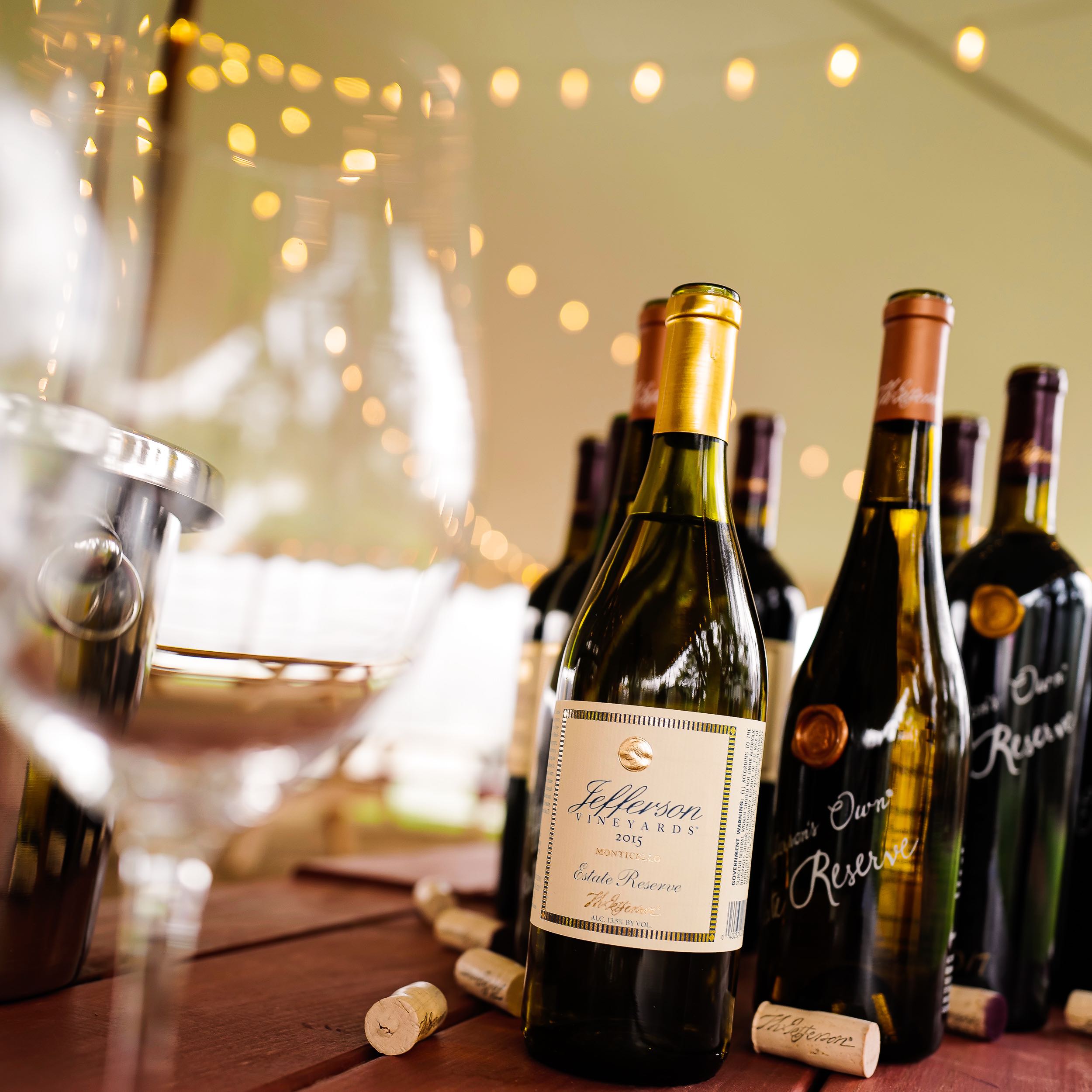
When our greatest fruit reaches optimal sugar levels, we bring it to the winery and here we start the process of crafting it into our to become an Estate Reserve wines. Purposeful consideration continues. For Estate Reserve wines, our winemaking team prefers new, French oak barrels. Estate Reserve wines will age for far longer than our other wines. Where approximately eight months will do for our other wines, Estate Reserve wines age for sixteen to twenty-four months. The tighter grain of young French oak barrels better manages this aging process and lends a more elegant finish to the Petit Verdot, Merlot, Cabernet Franc, or Viognier of which our Estate Reserves are so frequently comprised.
The varietals from which our Estate Reserve wines are usually created – Petit Verdot, Merlot, Cabernet Franc and Viognier - are the varietals that grow best on our land. They capture the best expressions of this place, the potential of which engendered our story. The 2014 Estate Reserve, for instance, is a fine wine made entirely of Petit Verdot. Aromas of cherry layered with vanilla open before luxurious blackberry and raspberry flavors on the palate, followed by a velvety finish with ripe blueberry notes. Our 2016 Estate Reserve is also composed of Petit Verdot but a different vintage offers a different experience. Notes of vanilla, spice and fig on the nose, preface a balanced palate of plum and wet stone and a lengthy finish with spice, heavy tannins, and hints of cedar. The following year’s Estate Reserve, 2017 Estate Reserve, is based instead in Cabernet Franc, with notes of oak, herbs, and tobacco before a balanced palate and lengthy, refined finish. Our 2019 Estate Reserve White, on the other hand, opens with floral and ripe peach aromas. Soft layers of peach, lychee, and honeysuckle define the palate before a smooth, round finish with flavors of brown sugar and refreshing acidity. This elegant, refined Viognier wine just won a Double Gold medal at the prestigious 2021 San Francisco International Wine Competition, making it one of America’s finest wines.
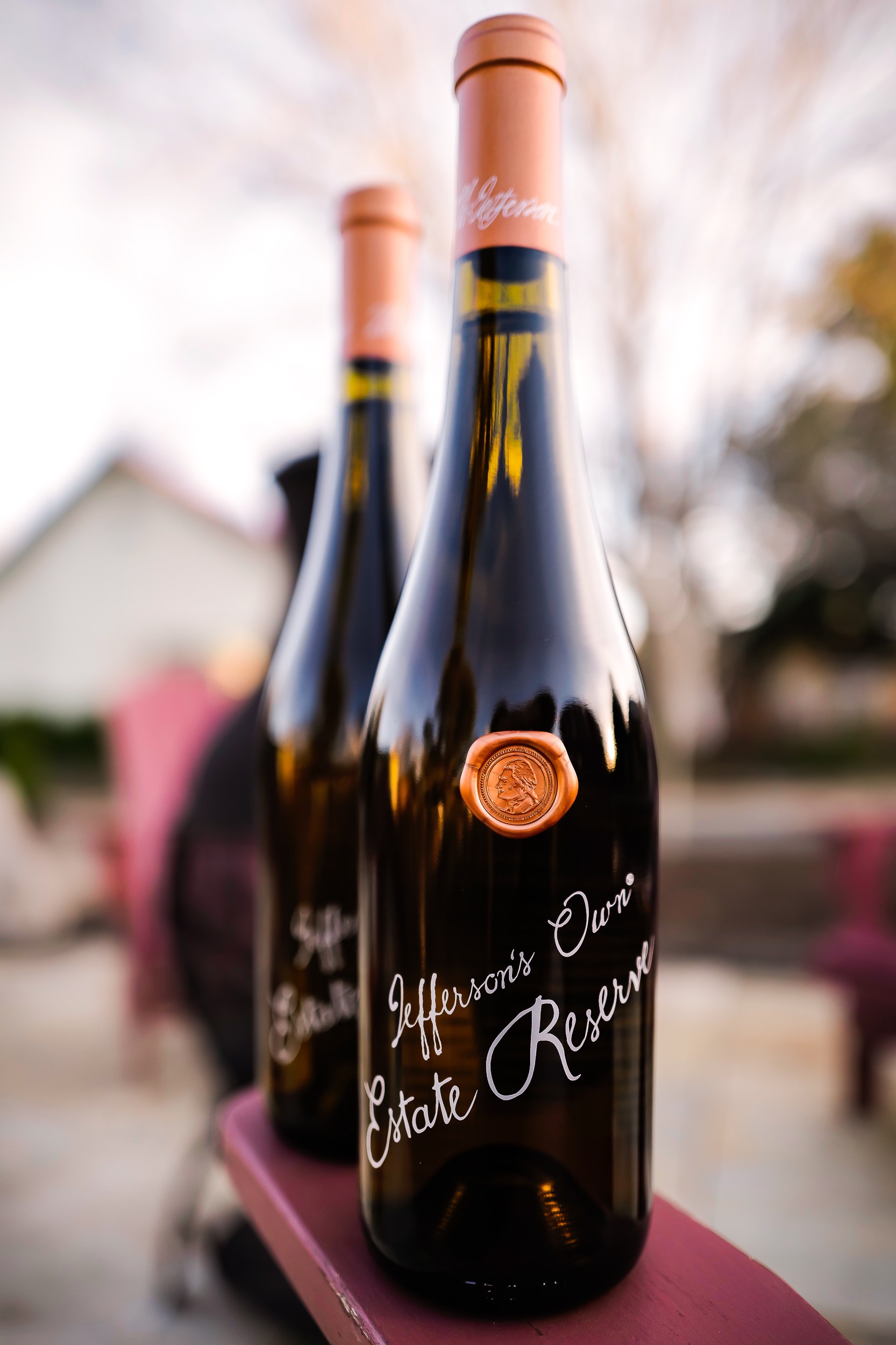
Find these and more in our curated selection of Estate Reserve wines. So as we close a year of celebrating these past 40 years, we offer you tastes of our story from along the way - stretching as far back as 2012.
Allison Scott, Our Office Manager
Jefferson Vineyards isn’t the only one turning 40 this year. November marks a big birthday for me also, and I intend to celebrate with one of my favorite bottles of Jefferson Vineyards wine, our beloved Meritage 2014. The jammy nose and long herbaceous finish bring back memories of chilly fall evenings. And is delightful when served alongside a Thanksgiving meal; I prefer it towards the end of the meal, post-turkey! Whether you are going for an all-out traditional feast or a vegan version for two this wine will elevate any celebratory meal. This November in particular, I look forward to seeing my friends and family on Thanksgiving, and marking significant milestones together!
A Meritage Tradition
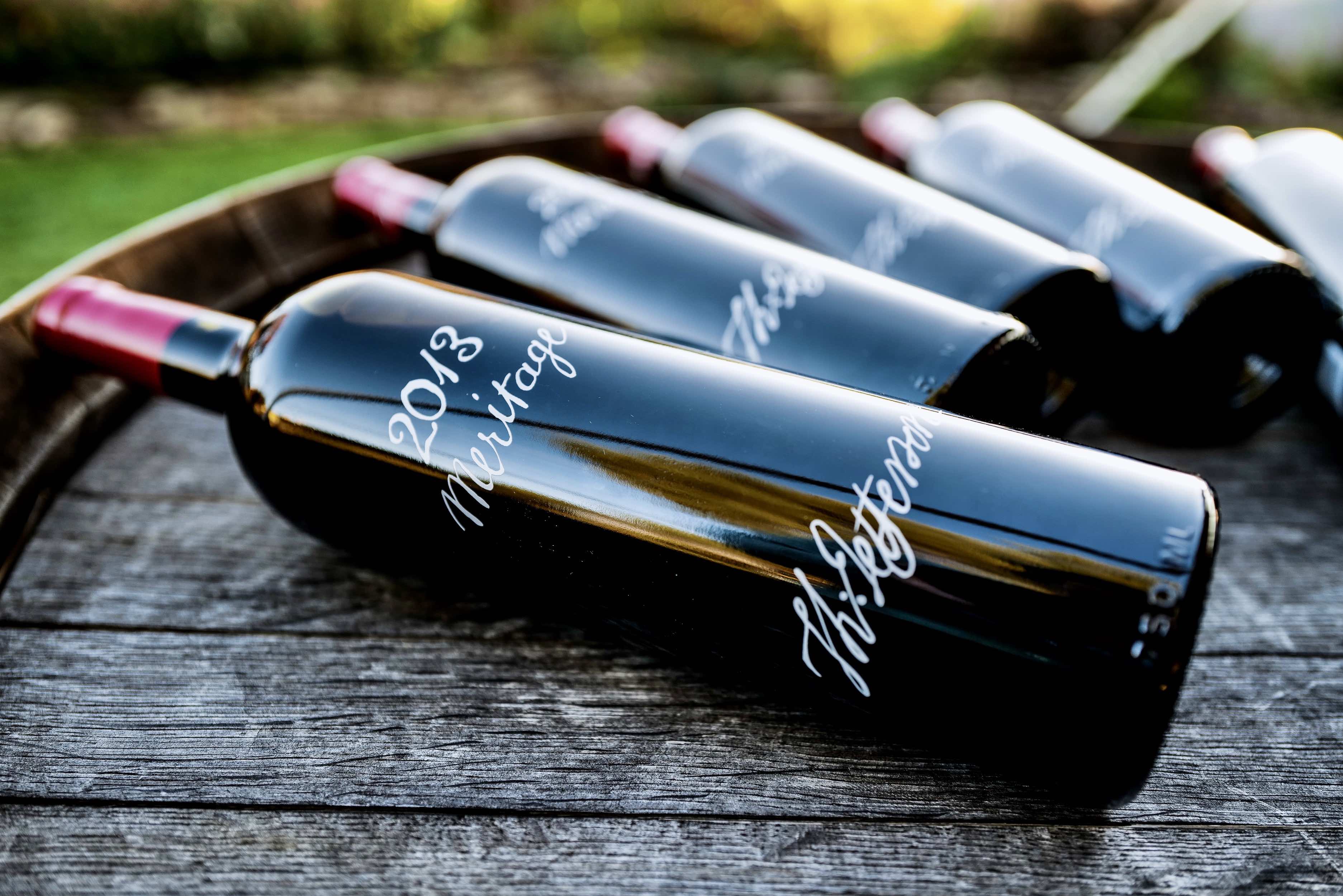
Not too long ago we collected the last of our grapes from their vines. Now, they’re fermenting in the winery, tucked away becoming something new, something unique. Meanwhile, our holiday plans take shape. Once again, we’re only a few weeks away from the holiday season. Traditions continue and evolve. Though this year may not be the same as last year or the year to come, the sentiment remains - time reserved for one another, time dedicated simply to be together, sharing a meal. Whatever this holiday season may bring, we look to our Meritage wines to exemplify tradition re-invented.
Meritage: A History
To be called a ‘Meritage’, the producing winery must be a member of the Meritage Association and be blended solely from Bordeaux grape varietals. The term ‘Meritage’, and the associated alliance, was founded in the late 1980’s to create a New World term for wines blended in the tradition of Bordeaux [1]. Combining “merit” and “heritage”, “Meritage” is a nod to centuries of viticultural tradition preceding.
A Meritage wine must contain two or more of the Bordeaux varietals, none of which can comprise more than 90% of the total blend [2]. Cabernet Sauvignon, Cabernet Franc, Malbec, Merlot, Petit Verdot, St. Macaire, Gros Verdot, or Carmenère are among the Bordeaux varietals. At Jefferson Vineyards, our Meritage blends are typically comprised of Petit Verdot, Merlot, Malbec, Cabernet Sauvignon, and Cabernet Franc. With every year, the included varietals, and their composition change. Each vintage continues in the style and tradition of Meritage and the centuries of Bordeaux blends before it - silky texture and robust structure. But each vintage, unique in composition, each varietal influenced by that year’s terroir creates a distinct new Meritage.
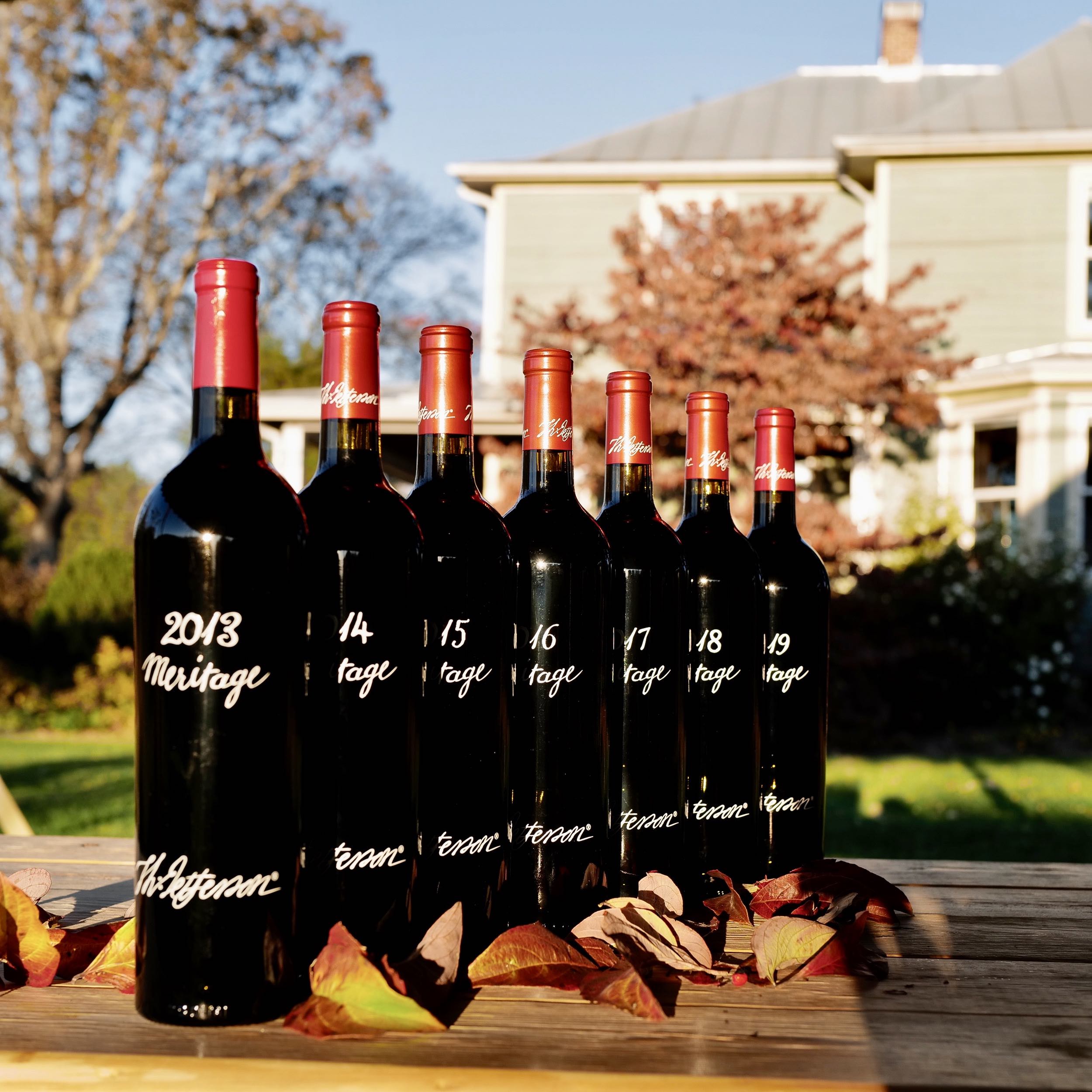
An Evolving Legacy
Our 2013 Meritage, our oldest vintage, composed predominantly of Petit Verdot, opens with robust coffee aromas on the nose, the palate is bright and filled with flavors of blackberry and spice, before a long and lingering finish. Yet, 2014 Meritage, still comprised mostly of Petit Verdot, is strikingly different though produced just one year later. Where coffee aromas previously set the tone, notes of spice, cedar fennel, almond and berry open the 2014 vintage. On the palate, berry flavors again dominate but blueberry and raspberry flavors are especially pronounced before a vibrant berry finish that lingers as its antecedent did but is instead, infused with notes of vanilla and more spice. The next iteration, 2015 Meritage, again maintains the Meritage family’s smooth and structured distinguishing characteristics but again, like each year’s iterations, differentiates itself. On the nose cedar, oak, and blackberry notes intertwine, the black cherry flavors preside over the palate with a bright acidity before more cherry and berry flavors mingle in the tannic finish with lingers spice notes. The pattern continues.
A Symbol of Tradition
The nuance of each Meritage expands the range of complementary food pairings, but certain combinations will never disappoint. For darker meats, fattier meats, nearly any Meritage will do. Chilled Meritage of any vintage balances the charcoal seasoning given to food by the grill. Enjoy your 2017 Meritage with roast pork, or our 2018 vintage with lamb. Explore Meritage from year to year, finding in each vintage a new food pairing, a new experience. Find the above-mentioned vintages and more in this month’s featured wines.
Meritage wines transform with every passing vintage while holding steadfast to wine’s core characteristics. It is a new experience with each year not dissimilar to the holiday traditions around the corner. Whatever traditions have or have not changed for you and your loved ones this holiday season, we hope you stay true to the core of your celebrations, stepping aside to cherish time together.
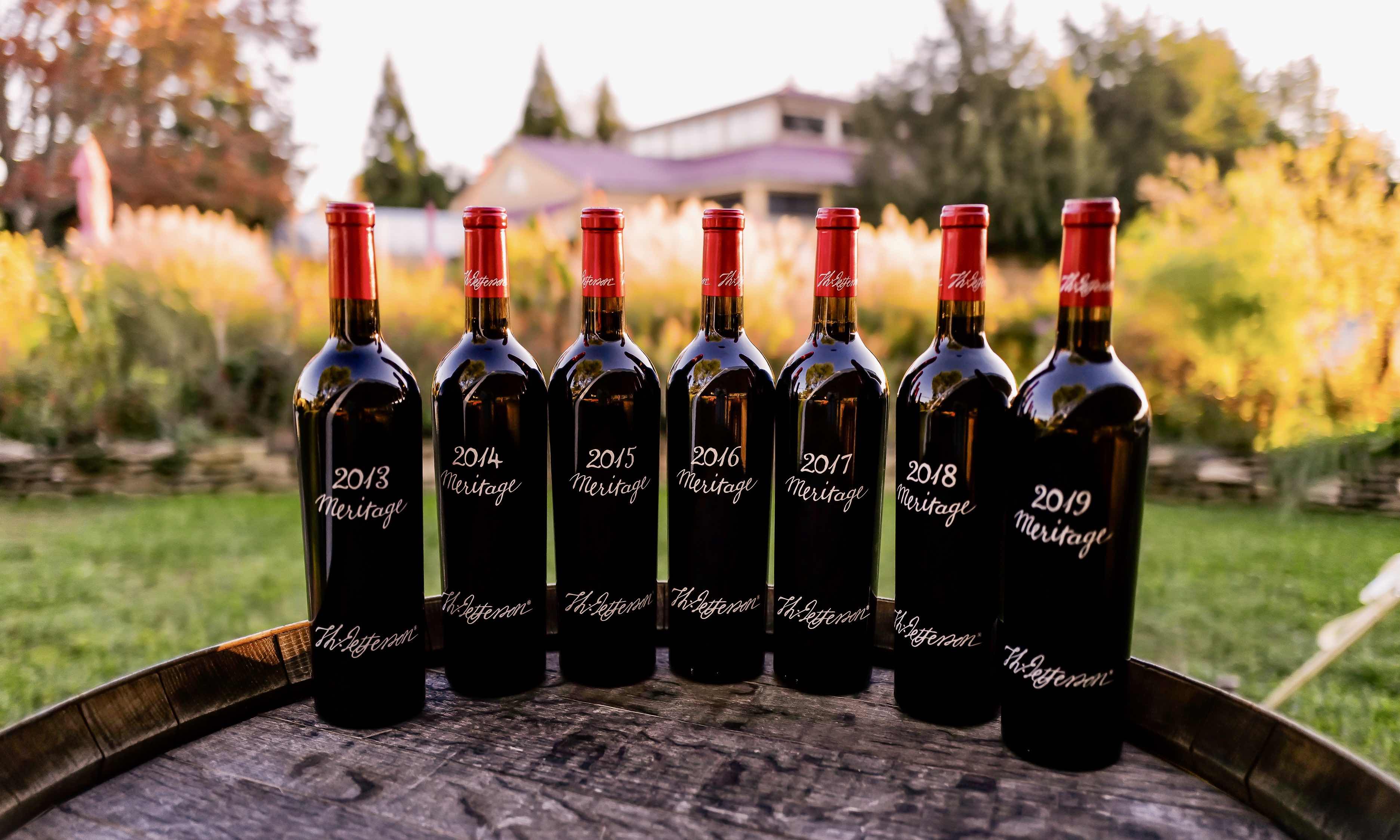
[1] What Is Meritage? - Meritage Alliance. http://www.meritagealliance.com/what-is-meritage/. Accessed 3 Aug. 2021.
[2] Red Meritage - What Is Meritage? - Meritage Alliance. http://www.meritagealliance.com/what-is-meritage/red-meritage/. Accessed 3 Aug. 2021.
The Wonderful World of Cabernet Franc
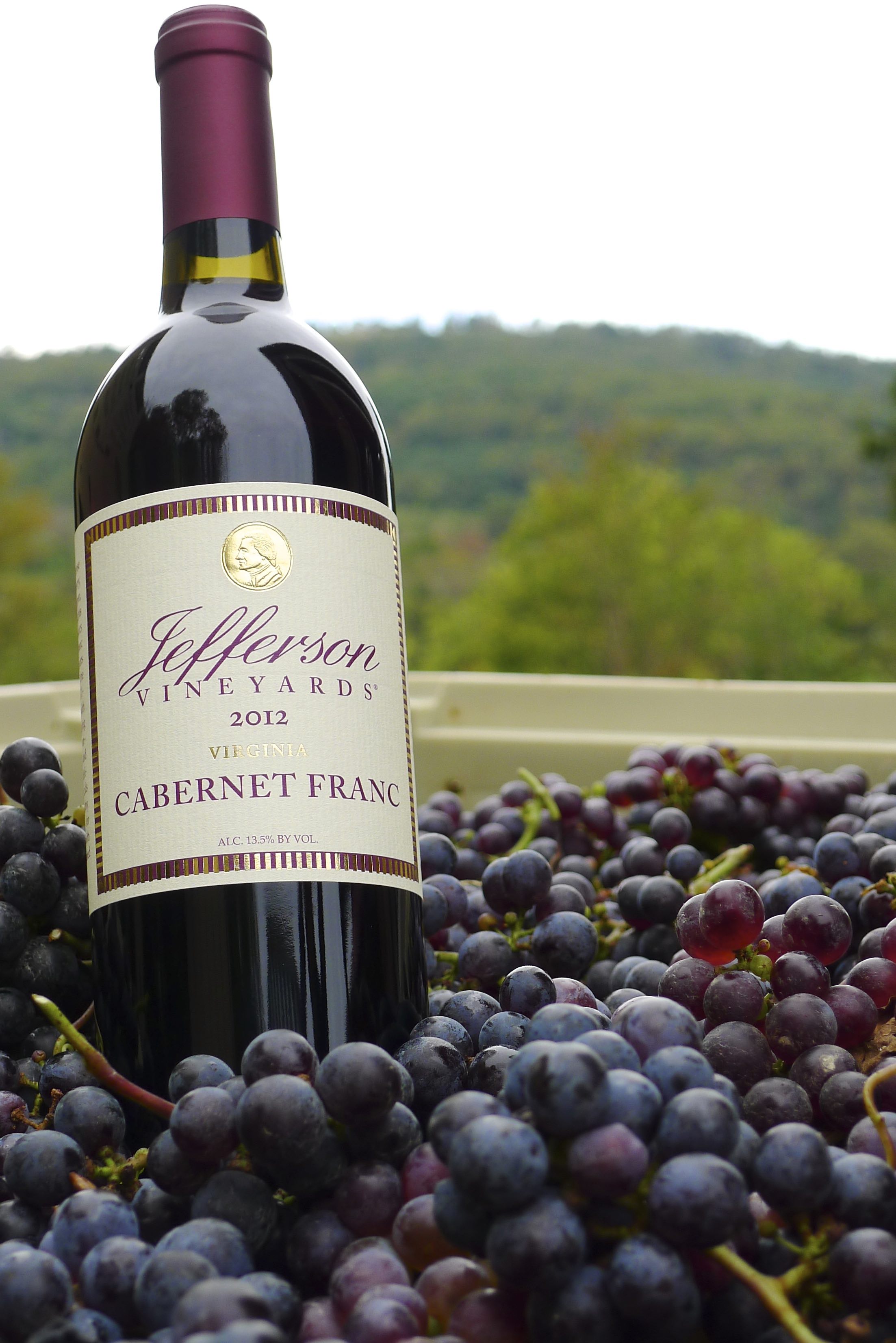
Finally, it begins. After a year of patience, a year of care, monitoring every vine, every cluster of new fruit, a year spent optimistically, expectantly - it begins again. Harvest, and with it, the start of a new vintage.
For the entirety of each year, we turned our attention to our vines. We hold our breath with every drastic turn of the weather – from Winter’s coldest nights to Spring’s heaviest rainfalls, and Summer’s blistering heat. For months, our team busied themselves cutting away rogue shoots and training the remainder to grow up towards the sky. We manually pulled leaf by leaf from the vines, regulating how much light reaches the growing fruit and ensuring air will flow freely through the trellised vines. Hundreds of hours spent between the neat vineyard rows, spent in every season, taking notes on the vines’ response to the heat, humidity, and parched earth, waiting to arrive, finally in Fall.
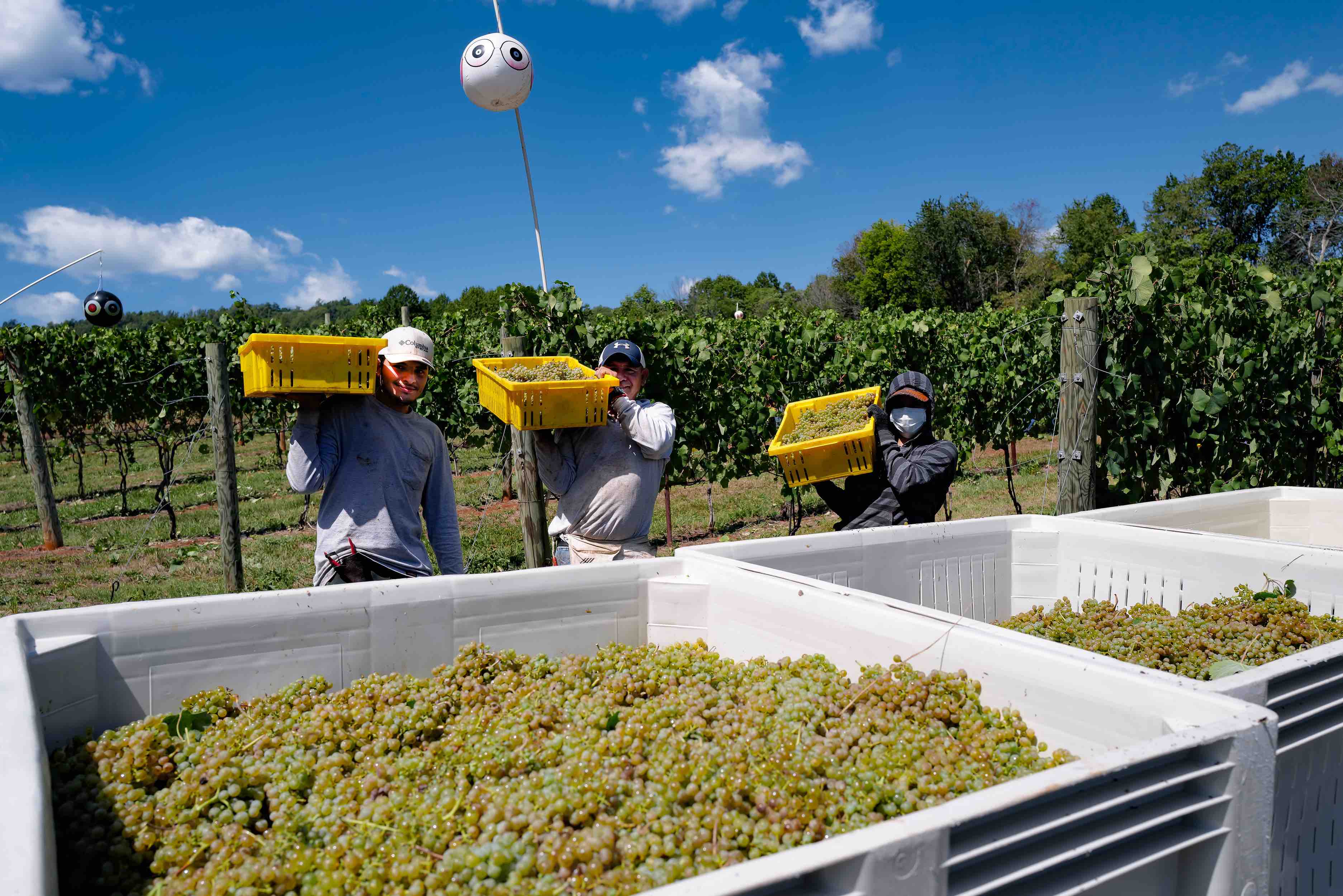
We began by harvesting the white varietals, the earliest to break bud, and which, in late August are first ready to be harvested. Pinot Gris and Chardonnay, alongside the Riesling and Viognier, mature most quickly, reaching the optimal brix levels (a measure of the fruit’s sugar). Day by day our team tests and records the fruits’ progression until now, when all indicate the best time to begin collecting fruit. Then, in September’s shortened days, the first of our red wines reach optimal maturity. It is at that time when we begin harvesting Cabernet Franc.
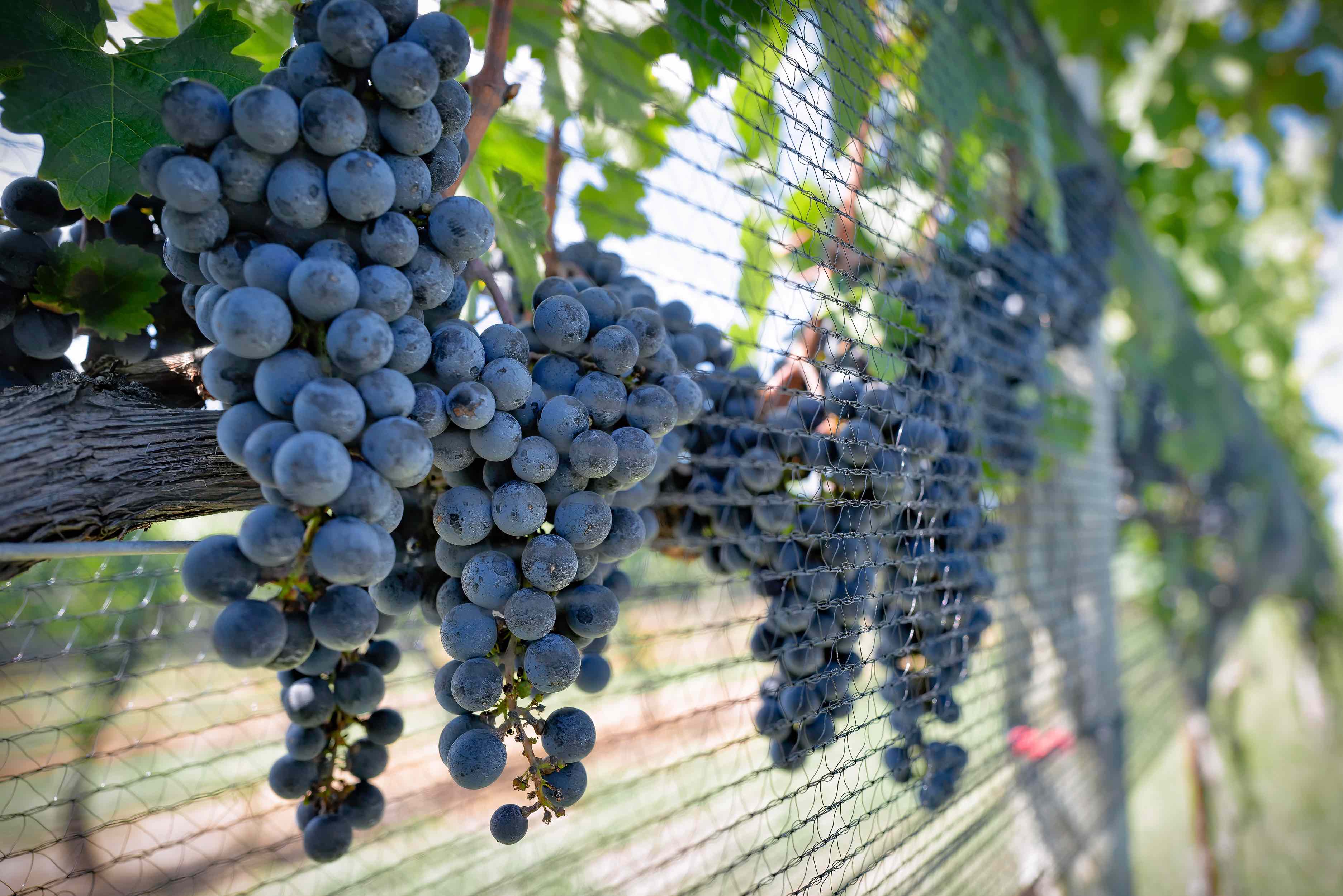
Cabernet Franc is an ancient varietal, the parent grape to the much-beloved Merlot and Cabernet Sauvignon varietals as well as the unique Carmenère grape. Hailing from France’s illustrious Bordeaux growing region, each of these grapes boasts bright red fruit flavors and supple tannins much like their Cabernet Franc parent. Merlot, Cabernet Sauvignon, and Cabernet Franc comprise what is known as the ‘Bordeaux Blend’. Borrowed from the same region in which these grapes originated, the Bordeaux Blend is primarily composed of Cabernet Sauvignon, Merlot, and Cabernet Franc, with smaller percentages of Petit Verdot, Carmenère, and Malbec. [1, 2] Though the percentages of each will vary from place to place and winemaker to winemaker, the blend itself is as renowned as its founding region.
Medium-bodied with strawberry, raspberry, and even bell pepper, the robust Cabernet Franc grape gowns amenably in a range of climates. In each, different flavors arise. In cold climates, the varietal’s sharp, tart flavors come forward and its acidity becomes more pronounced. In warmer climates the varietal’s sweeter side arises, sweet strawberry and dried fruit flavors become more pronounced. Cabernet Franc grows well in so many regions due, in part, to a group of compounds called methoxypyrazines. A naturally-occurring pest deterrent, methoxypyrazines create a pepper flavor in the wine. This flavor too will change with climate but is most frequently described as bell pepper. [3]
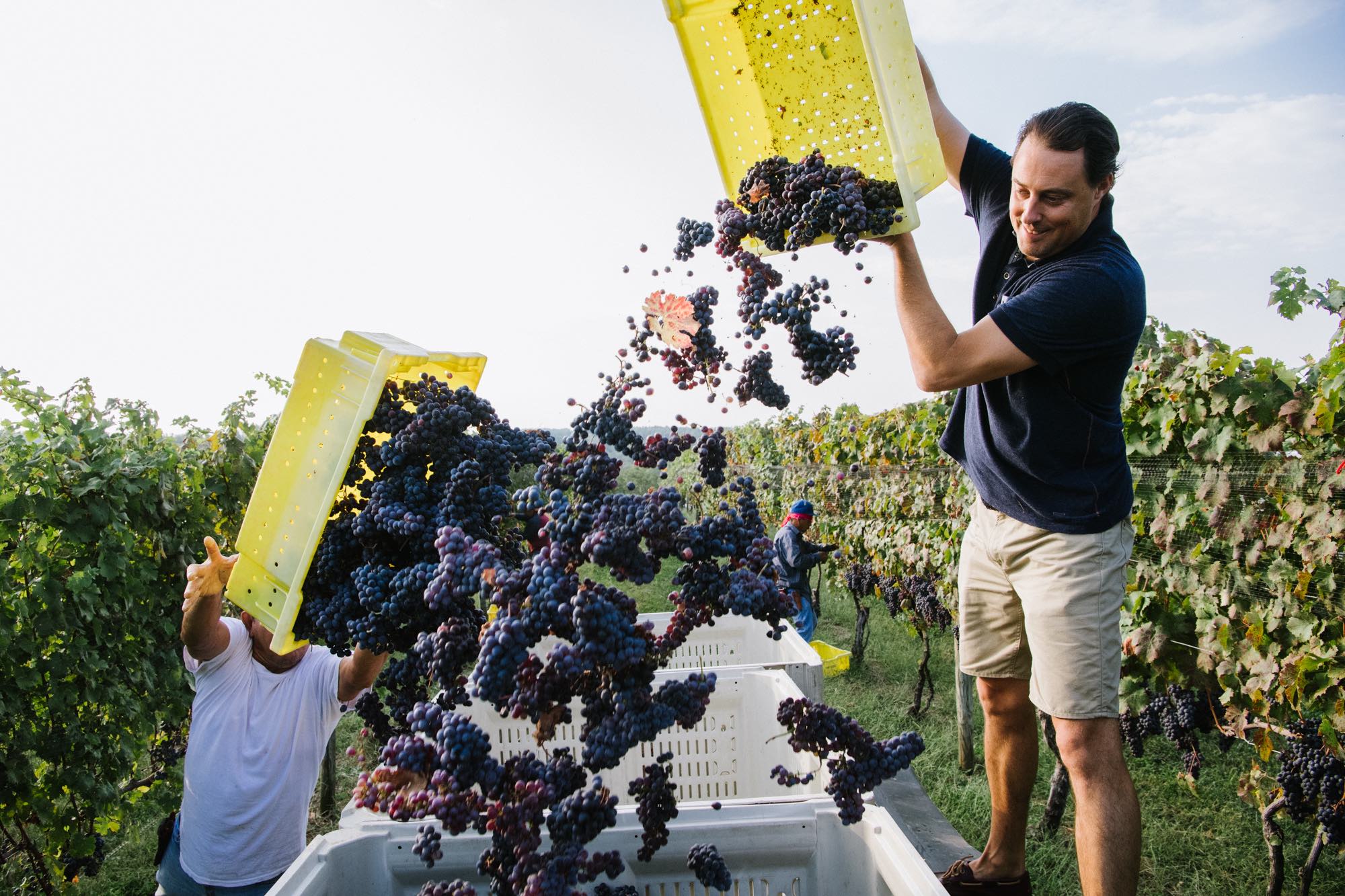
Cabernet Franc flourishes in our vineyards and across Virginia. We presently grow our Cabernet Franc in our Apple Vineyards where they are protected from the afternoon heat and their acidity is better preserved. We supplement our vineyard’s fruit with Cabernet Franc from Silver Creek vineyards located 40 miles down the road to protect against the unpreventable and offer diverse Cabernet Franc flavors. Yet, Jefferson Vineyard’s history with Cabernet Franc is nearly as old as we are. We first planted Cabernet Franc decades ago. Ever since, it has been a darling of our portfolio.
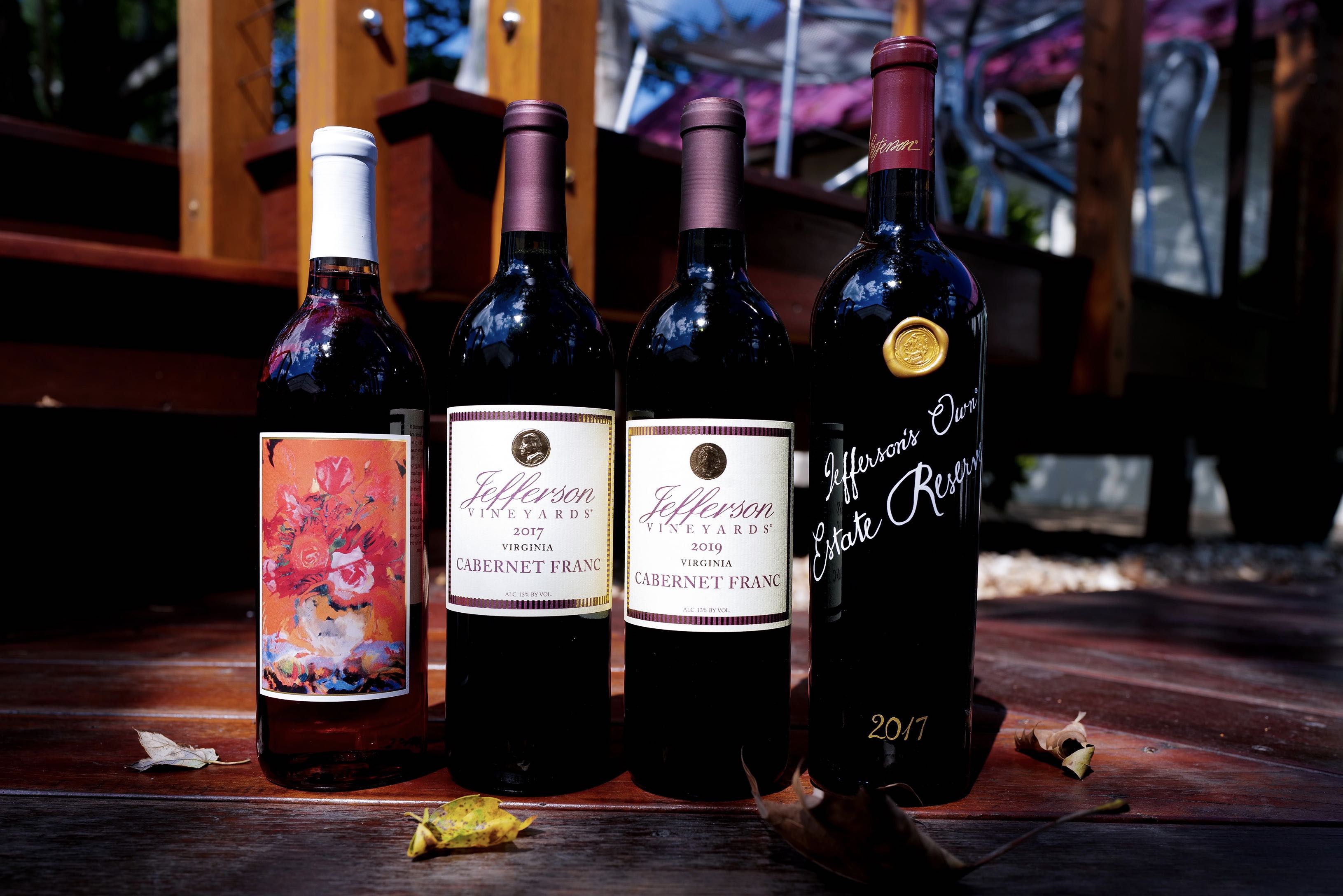
Our most recent 2019 vintage opens with aromas of dark cherry, vanilla, and floral components, before cherry and blackberry on the palate. With medium tannins and balanced acidity with a smooth finish, this wine was awarded Gold in the 2021 Virginia Governor’s Cup. But our Cabernet Franc offerings don’t stop there. To celebrate this robust, historic grape and its many flavors, we’ve collected our best Cabernet Francs in this month’s Featured Wines. There you’ll find our 2019 vintage as well as our highly awarded 2017 Cabernet Franc. In this vintage, aromas of dark cherry and cedar mingle with luscious dark fruits and balanced acidity on the palate before flavors of vanilla, and light pepper in the finish complements its soft palate. Should you prefer big, bold reds, you’ll also find our 2017 Estate Reserve. Comprised 52% of Petit Verdot and 48% of Cabernet Franc, this wine showcases Cabernet Franc’s strengths as a blending grape. With oak and spice on the nose, a strong acidity on the palate with black tea flavors before a fruit-forward finish, and balanced tannins, this bold wine is worth saving. To experience our Cabernet Franc in a totally new light, enjoy our Off Dry 2018 Rosé with pomegranate on the nose, ripe cherry, and juicy berry on the palate before a semi-sweet finish with a hint of tannin.
Our eager anticipation for Harvest, the beginning of a new vintage, calls into sharp contrast the legacy of this ancient grape. From its roots in Bordeaux, as the parent to many of the world’s favorite varietals, Cabernet Franc has found a happy home here, in Virginia’s Albemarle County. Find iterations of Cabernet Franc of harvests of past in our Featured Wines selection, and enjoy the range of flavors and wines crafted from Virginia’s own Cabernet Franc as we look ahead to a new vintage.
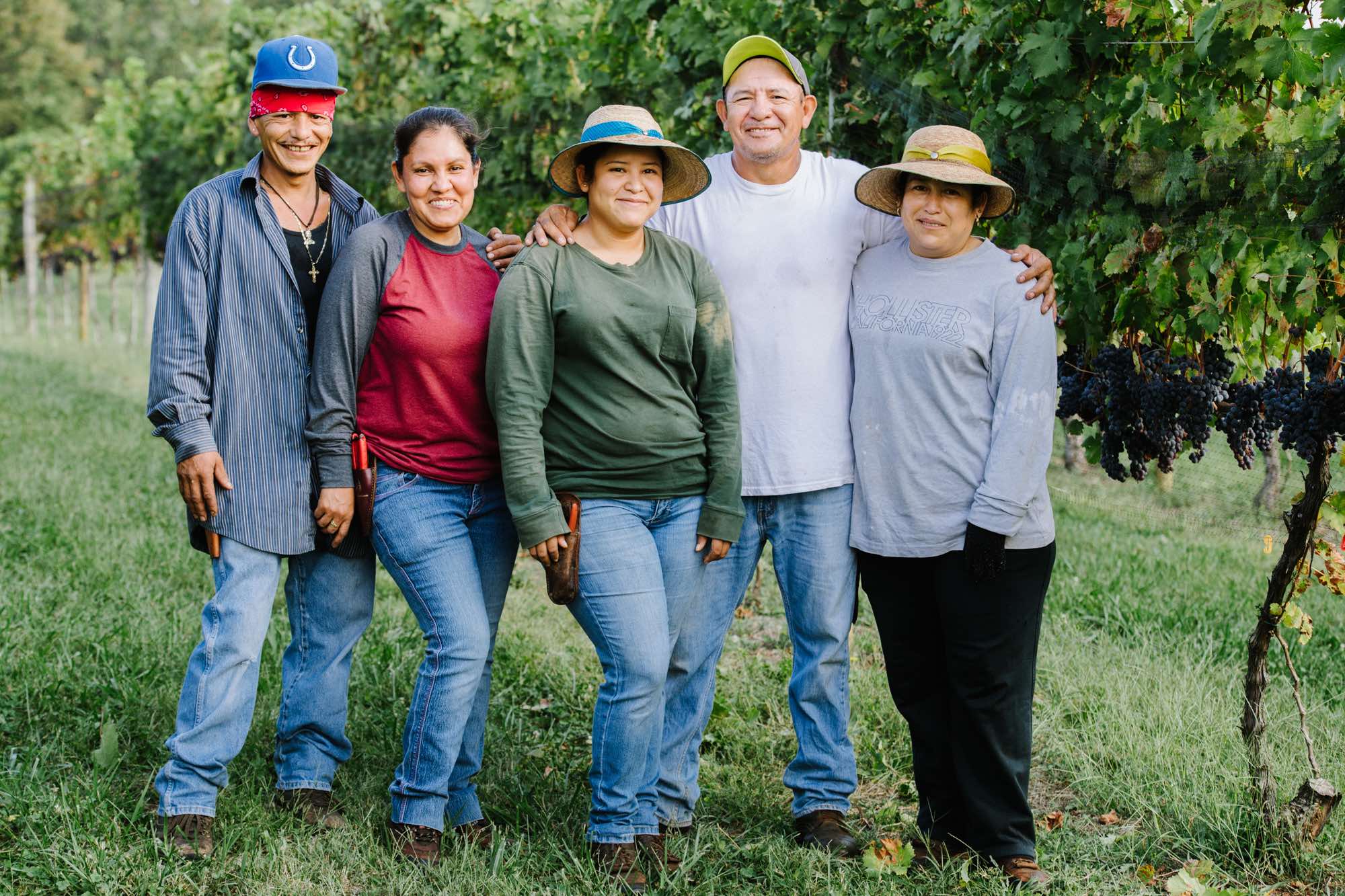
[1] Chris Mercer March 6, and Chris Mercer. “What Is a Bordeaux Blend? Ask Decanter.” Decanter, 9 Mar. 2020, www.decanter.com/learn/advice/what-is-in-a-bordeaux-blend 51789/#:~:text=A%20Bordeaux%20red%20blend%20usually,Blanc%2C%20Sauvignon%20Gris%20and%20Muscadelle.
[2] “What Grape Varieties Make up a Bordeaux Blend?” Wine Folly, 14 Apr. 2017, winefolly.com/deep-dive/what-grape-varieties-make-up-a-bordeaux-blend/.
[3] “Cabernet Franc.” Wine Folly, 12 Sept. 2018, https://winefolly.com/grapes/cabernet-franc/.
New Harvest & New Opportunities
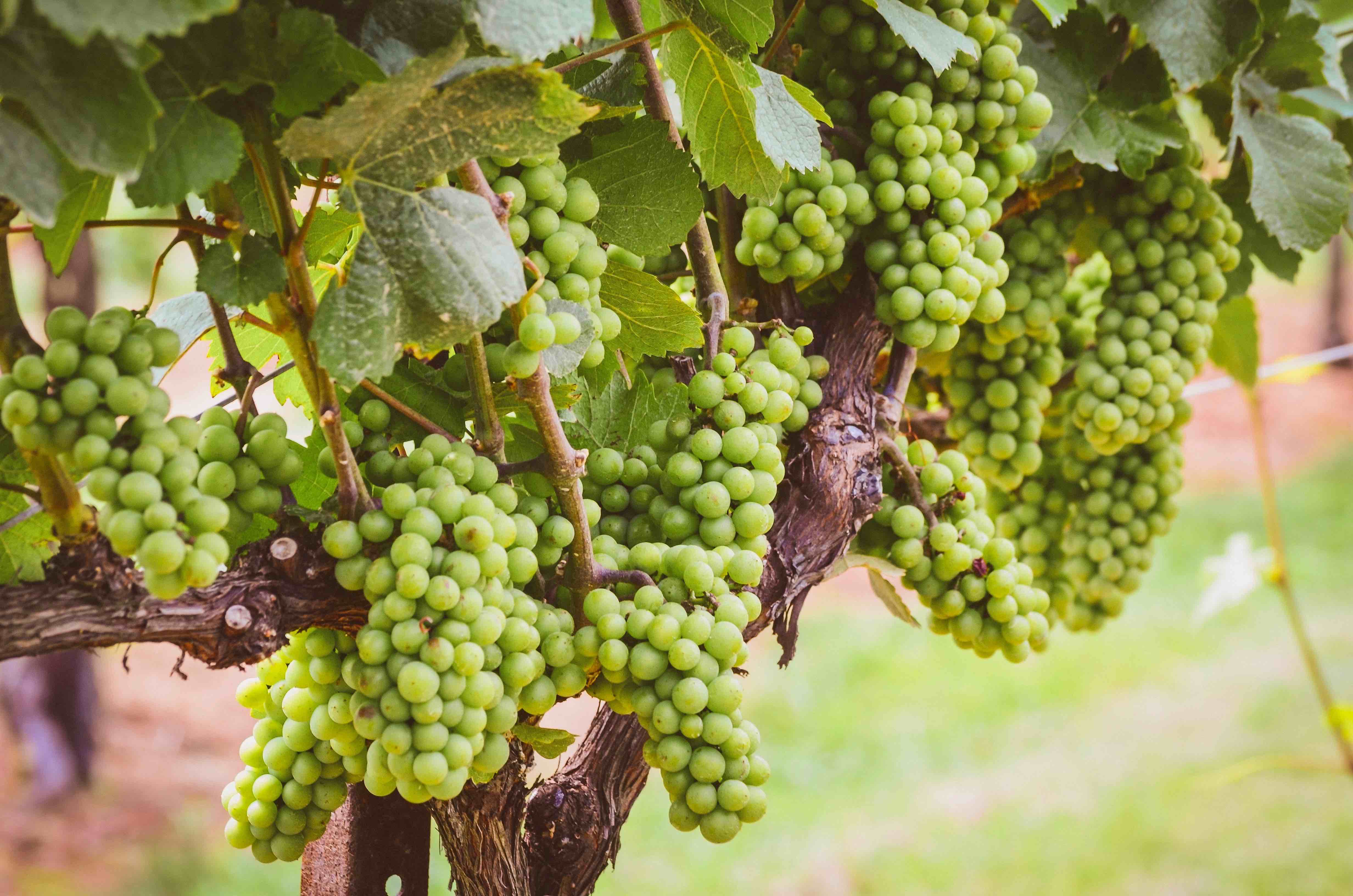
Harvest season is nearly upon us. With palpable excitement, our winery team is monitoring the grapes' evolution. Day by day, they collect samples from the grapes, eagerly anticipating the cue to begin harvest, the start of a new vintage. Each harvest renews a creative opportunity, a chance to enhance a harvest's particular essence in the winery, to highlight the best of every varietal in the wine you ultimately enjoy. Though there are standard procedures to which we adhere, the fermentation and aging processes give way to stylistic decision and the judgment of our wine-making team upon harvesting the fruit. With these decisions, fruit that may have come from the same part of the vineyard, perhaps even the same vine, become striking different wines, each worth enjoying.
Fermentation: A Tale of Two Choices
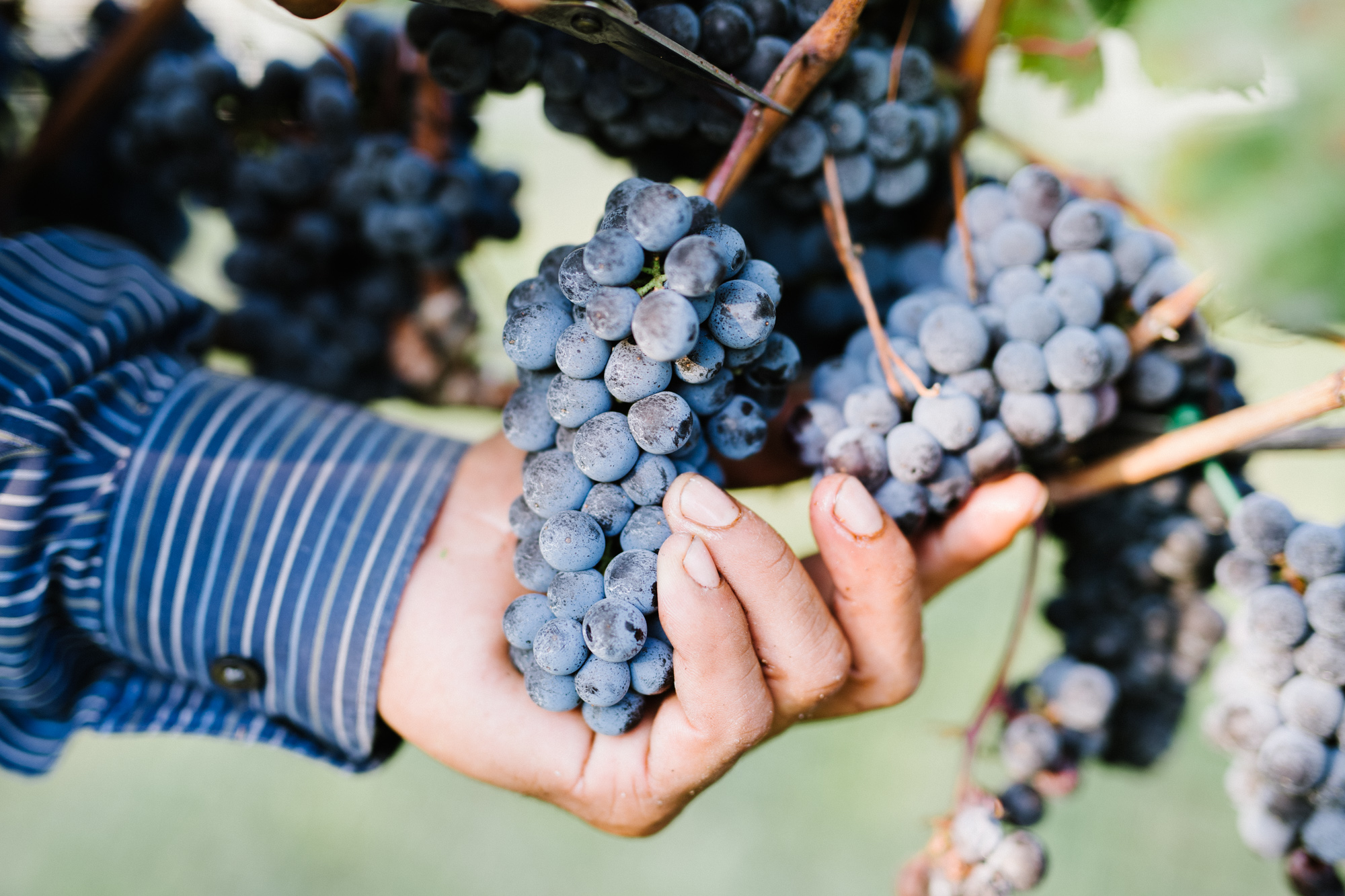
Once the grapes are harvested, processed, and sorted to remove any materials other than grapes (MOG), and they are taken into the winery. Here, they are pressed to break the fruits’ skins and release their juice before fermentation begins. Fermentation is the process by which the grapes and their juice become alcoholic. After a day or so, once the yeast is added to the grapes, the juice will begin to foam - an effect of the carbon dioxide released as the yeast consumes sugar from the grapes and produces ethanol in return.
White wines are quickly removed from the seeds and skins before fermentation while red wines sit with their skins, allowing the skins’ colors and tannins to impart on the wine. However, winemakers may choose to mimic this process with certain white wines, with optimal fruit quality and chemistry. By allowing these whites to sit with their skins and seeds longer, we make what are known as “skin contact” or “orange” wines. The additional time the white wine grapes spend with their skins alter the wine, adding a boldness and near tannic-life effect, and tinting the wine just slightly to become pink or orange in appearance. Take for instance the differences between our Pinot Gris and Skin Fermented Pinot Gris, or our Viognier and its skin-fermented counterpart.
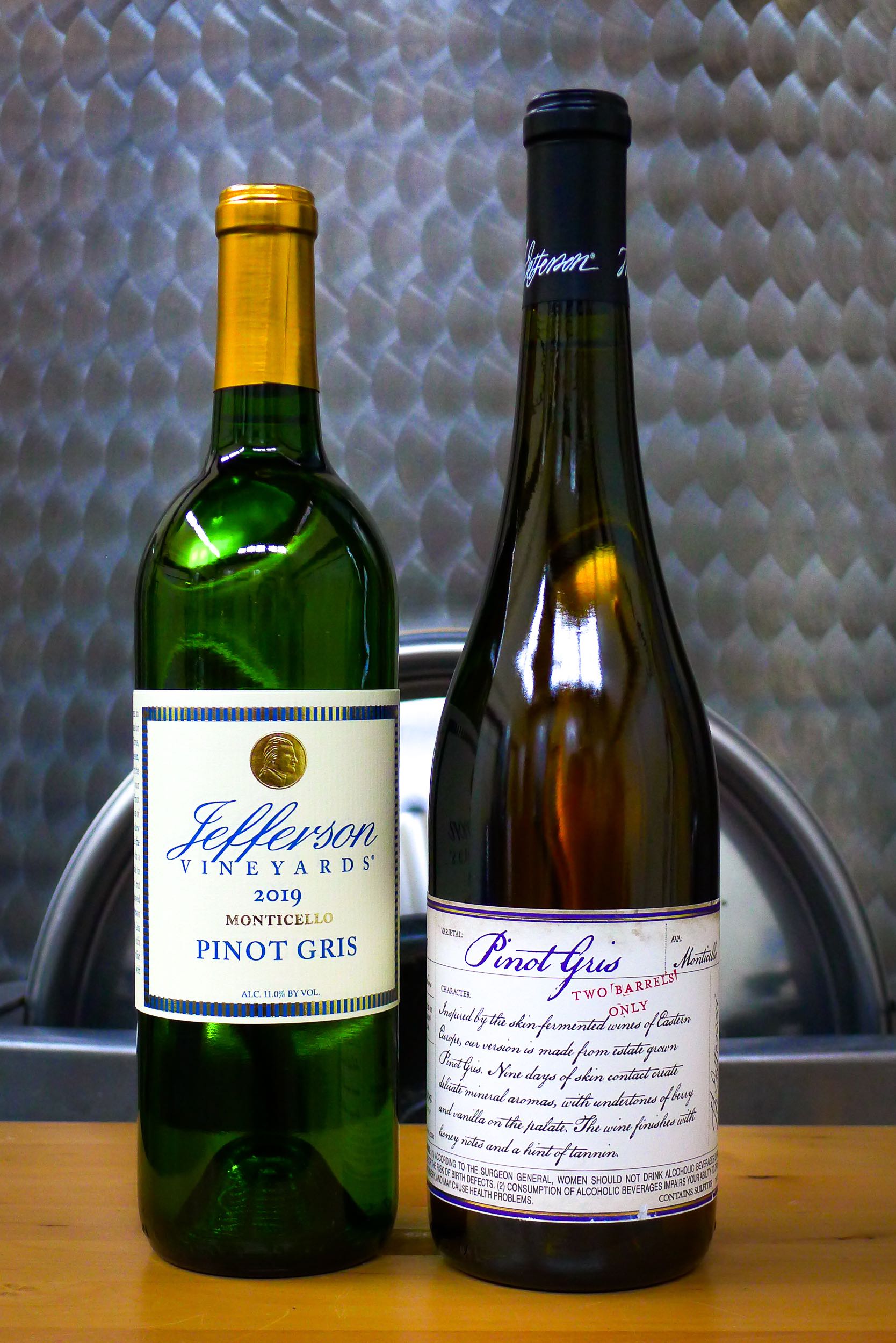
Harvested from our Church Vineyard, our 2019 Pinot Gris has clean, floral, and citrus aromas, followed by pear and melon flavors before a crisp finish. From the same vines, but with additional skin contact, our 2019 Skin Fermented Pinot Gris wine is noticeably distinct. On the nose, would-be citrus aromas are instead mineral and floral. On the palate, the skin-fermented Pinot Gris is marked by delicate strawberry cranberry andvanilla flavors before a lingering, honeyed finish with mild tannins.
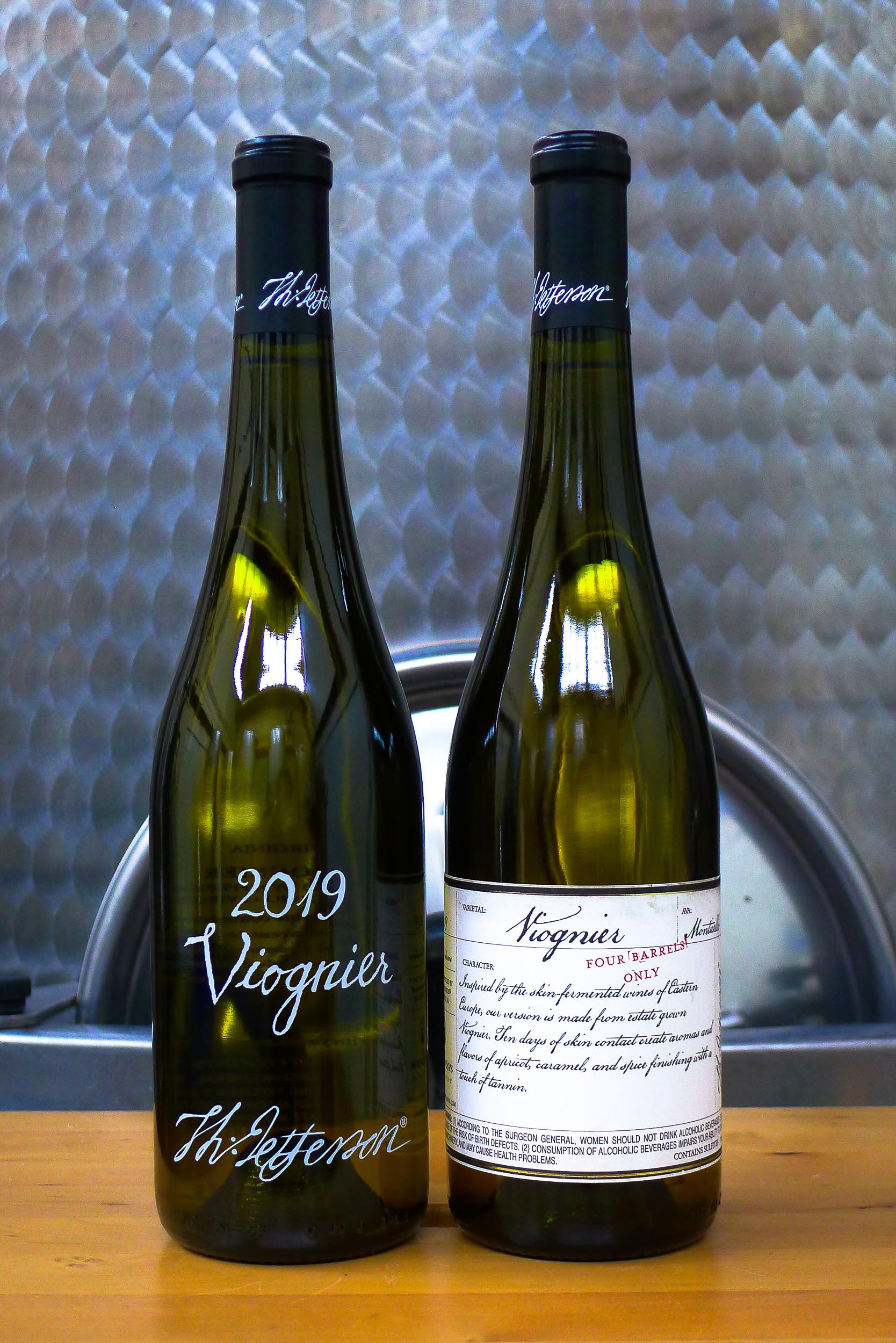
Our beloved Viognier is similarly transformed by skin fermentation. The 2019 Viognier claims intricate floral components, white peach, and nectarine; a delicate, balanced palate with additional peach flavors; and a lingering acidity in a predominantly floral finish. Alternatively, the 2019 Skin Fermented Viognier opens with prickly pear, citrus, and guava on the nose, a pleasant acidity on the palate is accented with tropical flavors of grilled pineapple and mango before a slightly tannic finish with notes of apricot.
Aging: Steel or Oak
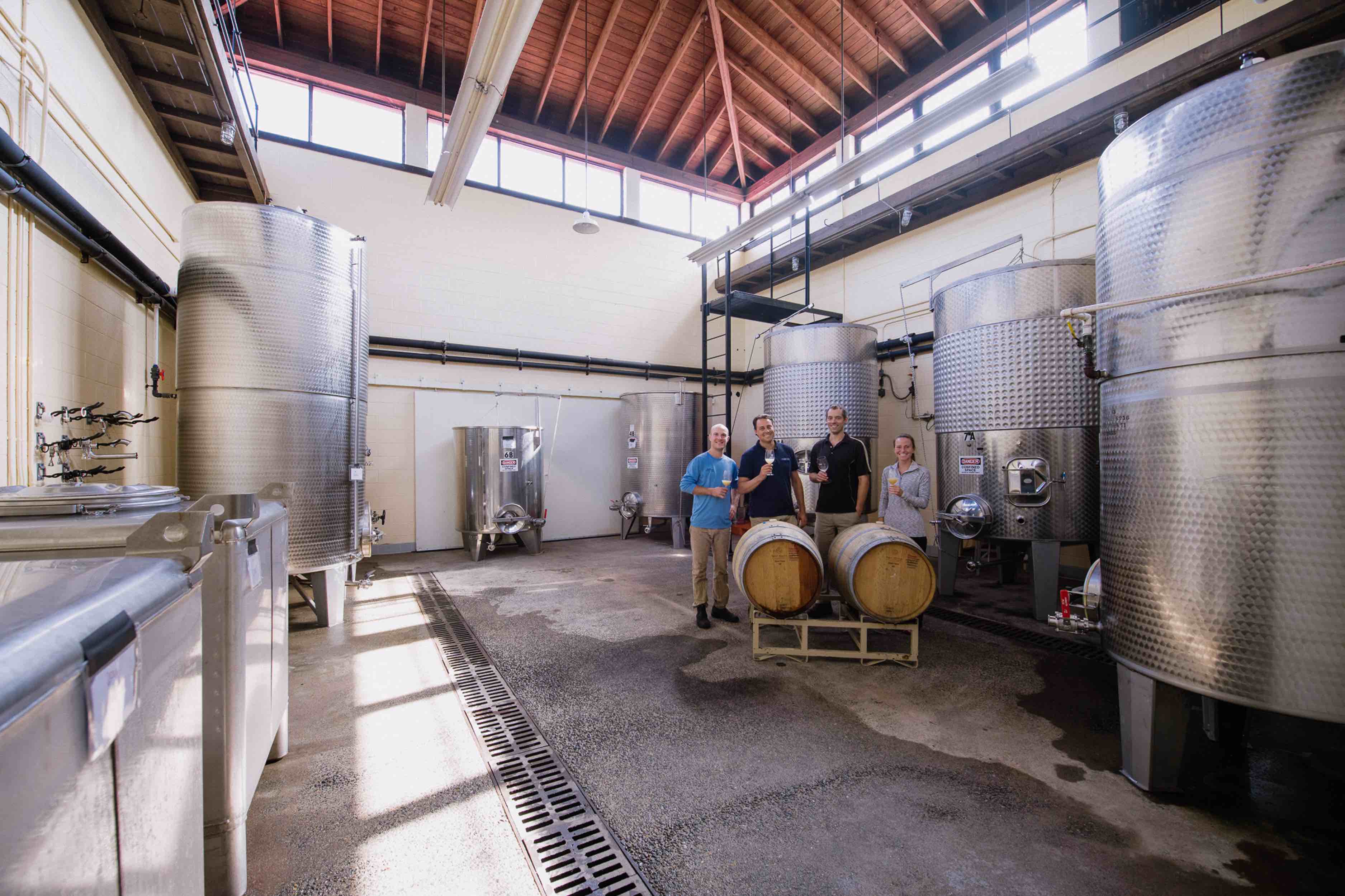
At the conclusion of fermentation, wine is ‘racked’ out of the fermentation tank and moved into a vessel to be aged. Again, our winemakers carefully consider how to age certain wines and different varietals. The age, treatment, and material of the vessels will impart unique characteristics on the wine and thus are considered as carefully as a chef would choose seasoning or a painter would mix a shade of color. Weighing the styles of wine for which we are known against the quality of a particular harvest and the magical chemistry that takes place inside the winery, our winemaking team prescribes a unique again process.
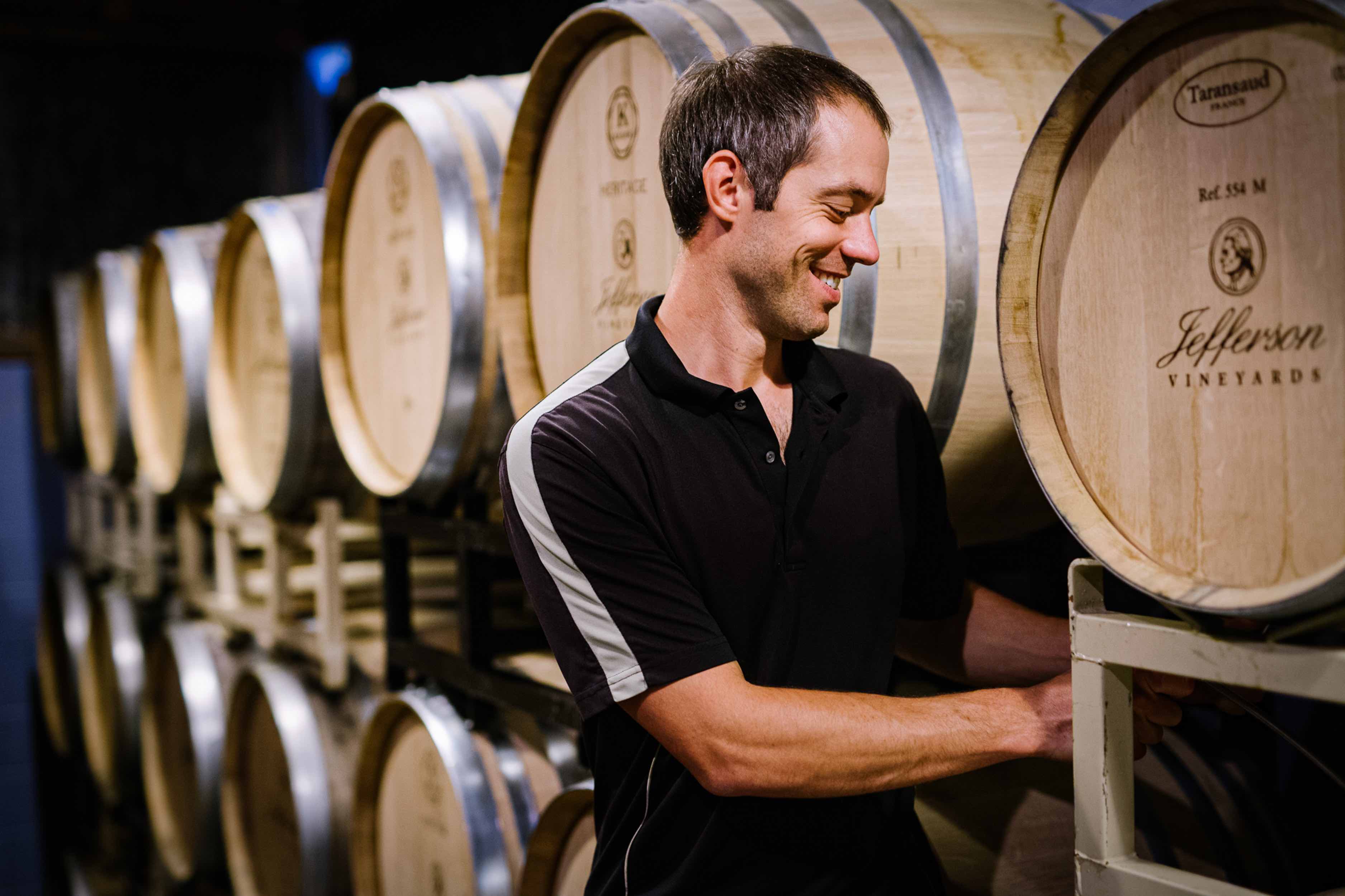
A barrel's oak type, age, grain, and treatment alter the wine. Wine aged in a young American oak barrel will be distinct from the same wine were it aged in old French barrels. As our winemaker, Chris Ritzcovan explains, “the addition of different barrels is akin to a spice rack in your kitchen. They are meant to enhance the wine, not overpower it”. We experiment with barrels of a range of oak species, from different regions, with differing treatments, and of varying ages to craft the best possible wine. As an organic material, oak barrels breathe, exposing a slow and steady supply of oxygen to the wine. The oxidation process diminishes the wine’s floral notes while allowing for richer flavors and greater smoothness to take hold. Alternatively, stainless steel tanks minimize oxygen exposure and thus the enclosed wine maintains bright floral and fruit flavors. Furthermore, if the influence oak barrel aging is akin to a spice rack, using a stainless-steel tank is to forego the spice rack entirely. A stainless-steel tank imparts no further flavor to the wine it holds, instead, the varietals’ flavors are untouched and maintained.
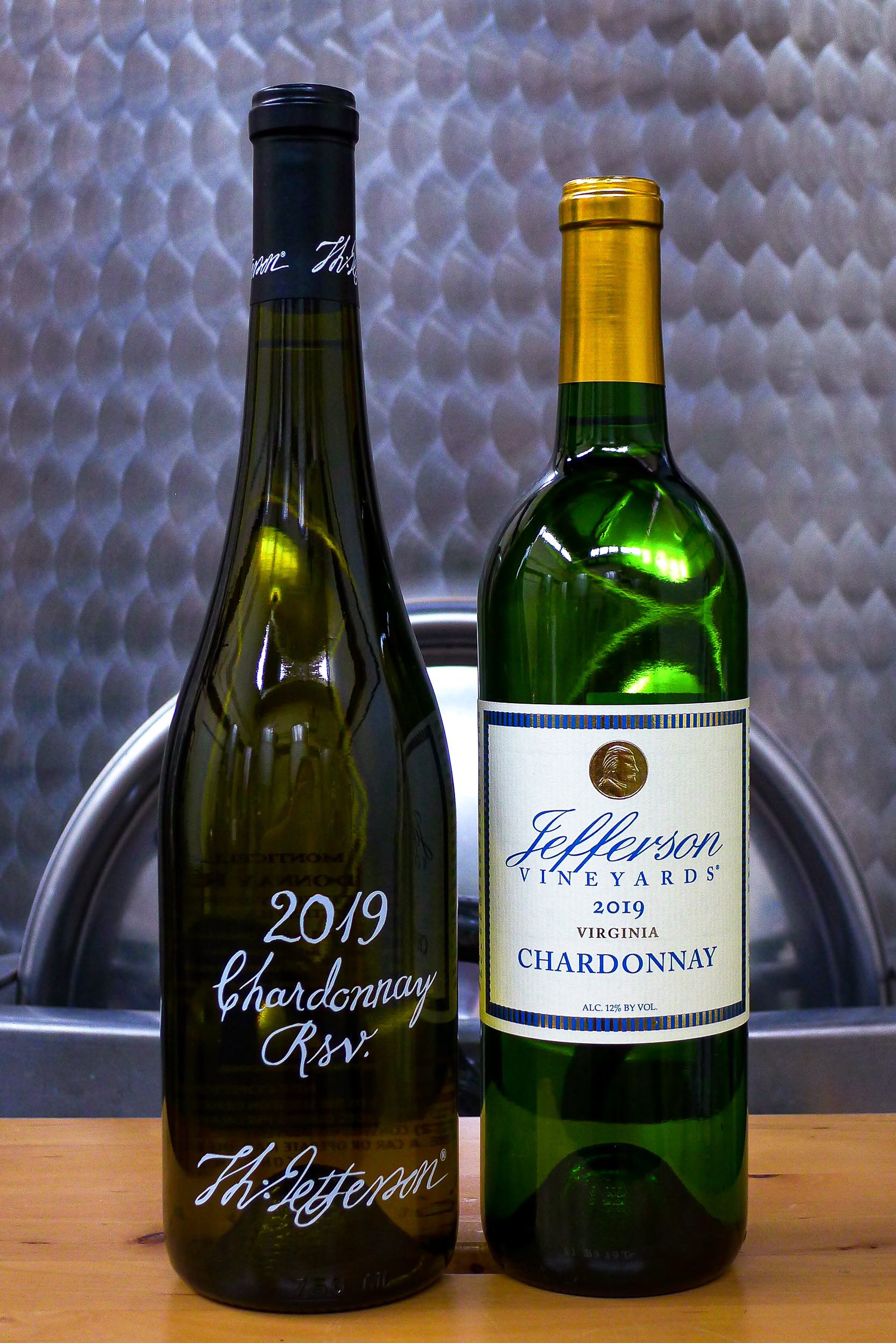
The difference between wines aged in steel versus oak vessels is best articulated by comparing our stainless steel 2019 Chardonnay and our 2019 Chardonnay Reserve. The stainless steel-aged 2019 Chardonnay opens with a bright bouquet of green apple and citrus. On the palate, the wine has tropical flavors with apple and pear before a crisp, acidic finish. Alternatively, the 2019 Chardonnay Reserve was aged for seven months in oak. This elegant wine opens with rich oak notes and vanilla on the nose, the palate is balanced with flavors of green apple and pear, before an elegant finish with notes of butter and toast.
A Call to Experiment
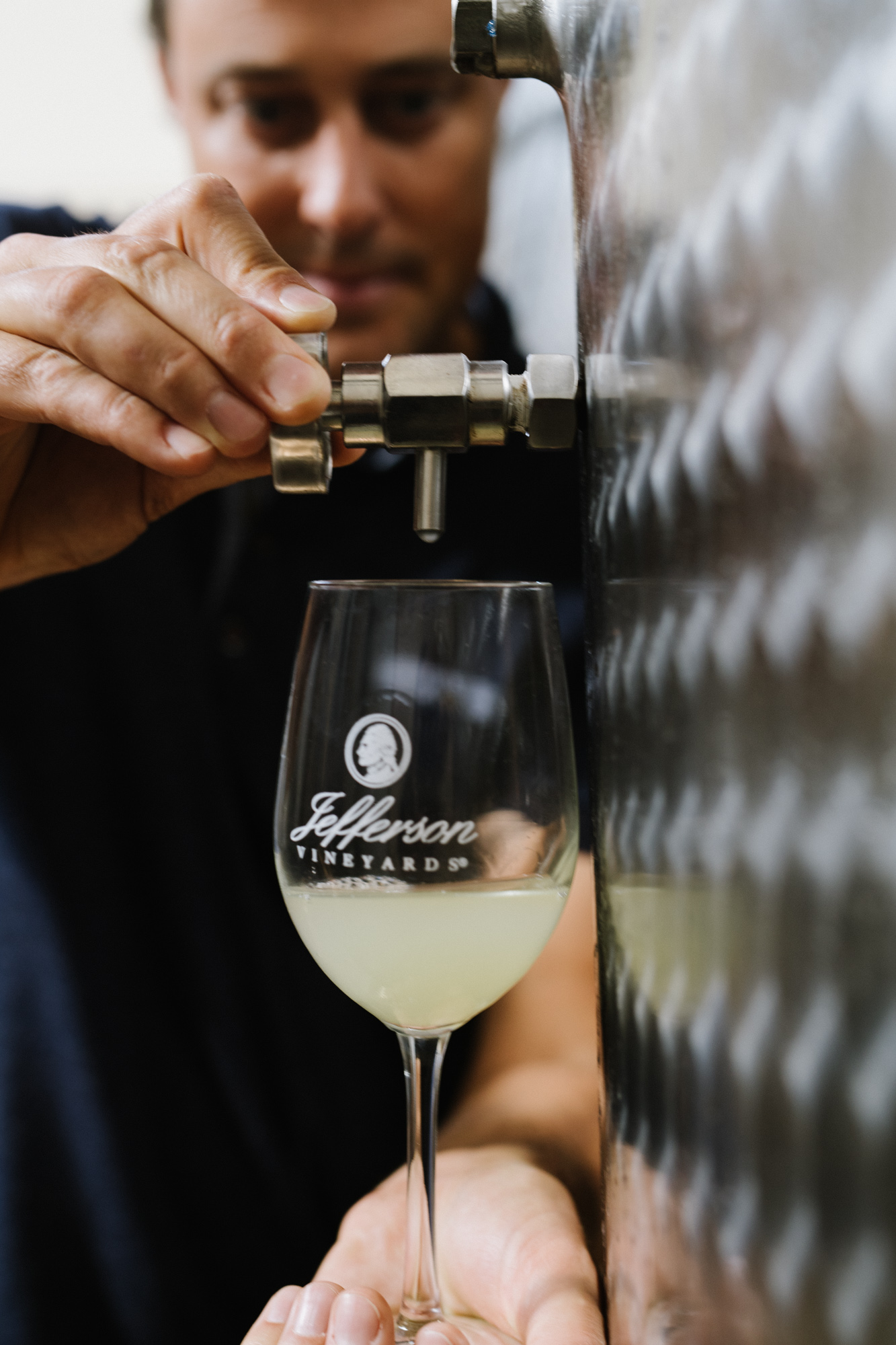
Throughout the winemaking process, we consider the nuances of each harvest and every varietal. Any decision made – be it fermentation technique or aging vessel – is made with consideration to the wine’s aromas, flavors, and notes. To taste wines made of the same varietal, grown on the same land, made unique by differing techniques is to directly taste the differences of a craft. This August, find every wine we mentioned above available for purchase in our Featured Wine Shop, paired with its fraternal twin. We encourage you to experiment, to try something novel to you – be it skin-fermented or stainless steel aged. Enjoy the transformed aromas, flavors, and finish between the two, and the varietal you thought you knew may transfigure into something new.
Chilled Reds & the Grill: A Perfect Match
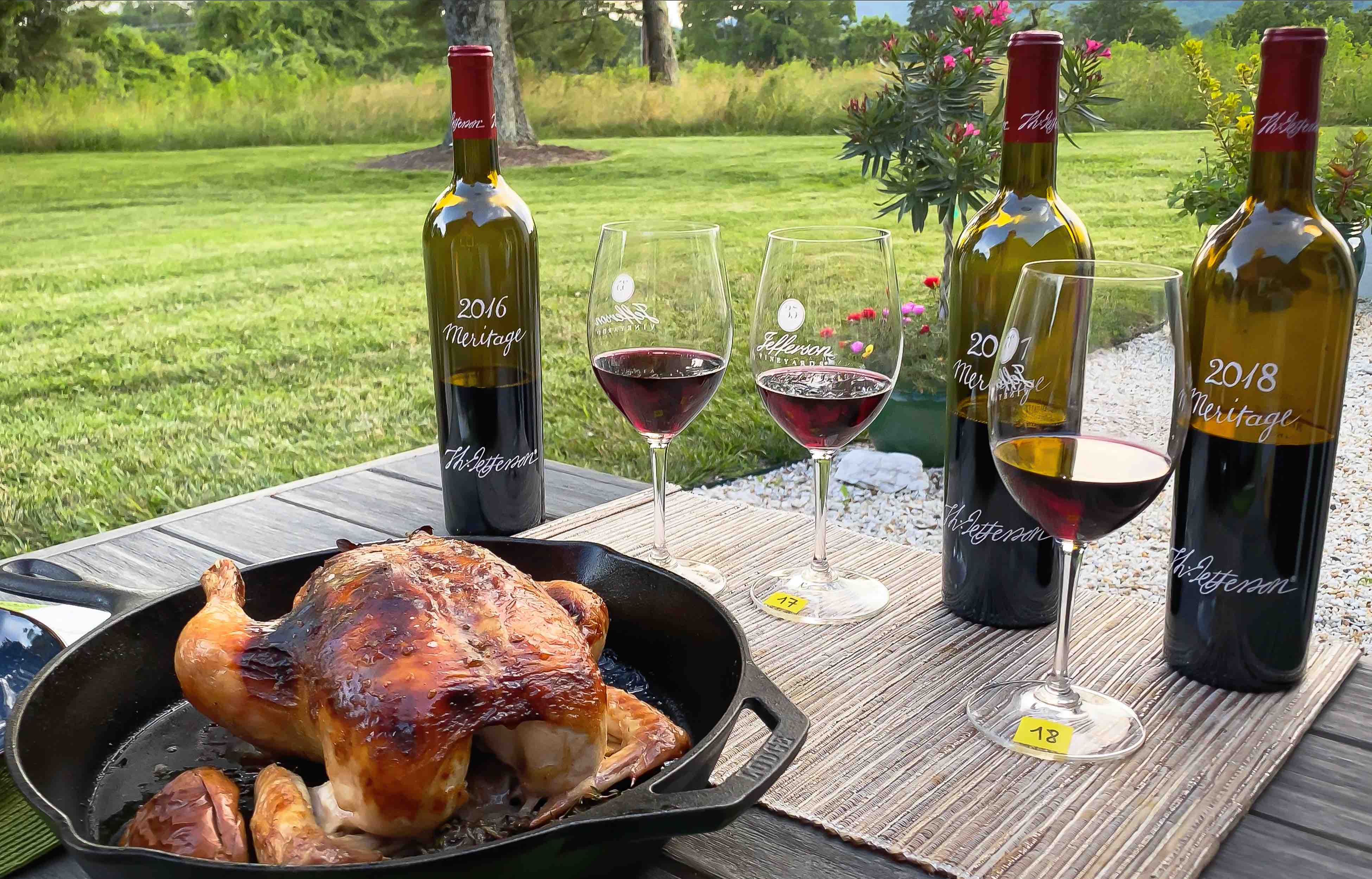
With a change in seasons comes a change in preferences. Long ago we traded heavy dishes for the bright, fresh flavors of Spring. For Summer – a Virginian Summer at that – again we seek food and refreshments to compliment the season. Now, we are grilling to enjoy the warm weather, bringing friends and family around for a meal made outdoors to be enjoyed on the spot. To drink, nothing but the most refreshing beverages will do. You might habitually reach for a beer, but don’t tuck away that fine red wine just yet. Below, find everything you need to know to delight in a glass of red chilled just right for a hot summer’s day - plus the grilled pairings to match.
To Chill A Wine
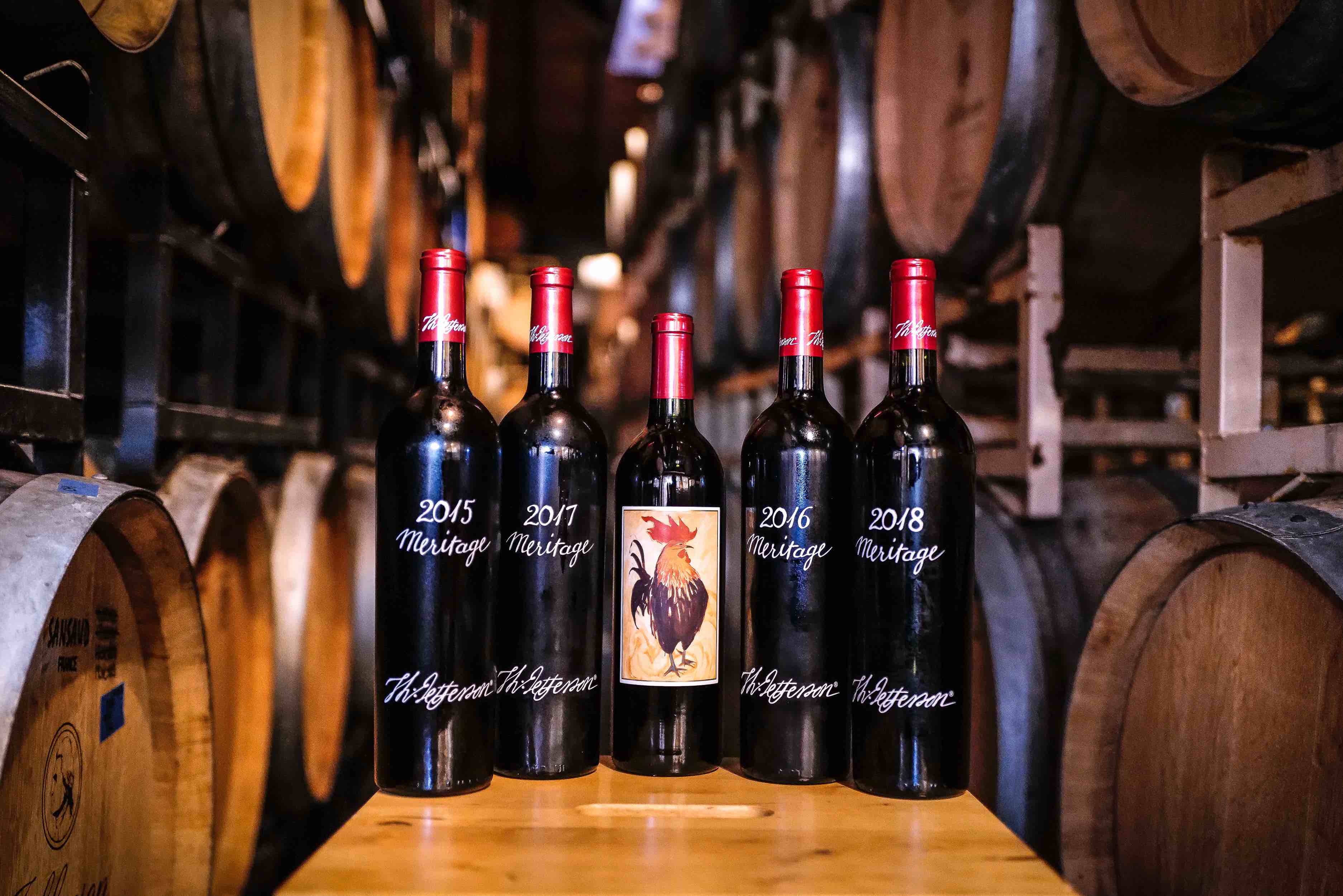
No longer do you need to forfeit your favorite red wine to summer’s sweltering heat. If handled correctly, even full-bodied red wines can be enjoyed year-round. Better yet, many experts recommended chilling your red wines but there is a careful balance to strike when doing so. If chilled too much, red wines become more tannic while the wine’s flavors become more subdued. If served too warm, the wine’s structure softens, subduing its acid, alcohol, and flavors. Of course, each wine calls for a slight variation in chilling protocol.
Generally, when served between 55-60 degrees, a wines’ best flavors surface. Lighter-bodied wines with a higher acidity do better with lower temperatures - the equivalent of about ninety minutes in the refrigerator. Meanwhile, full-bodied, tannic wines are best served slightly warmer– roughly forty-five minutes spent cooling down in the refrigerator. Alternatively, if you chill bottled wine in an ice bath mixed with a bit of table salt, you can bring down its temperatures more quickly. You may find you prefer certain varietals or vintages chilled to different degrees but whatever your preference may be, a perfectly chilled wine will be wonderful and refreshing. Enjoy it on its own or pair it with the right grilled cuisine to capture summer at its best.
Complimenting the Grill
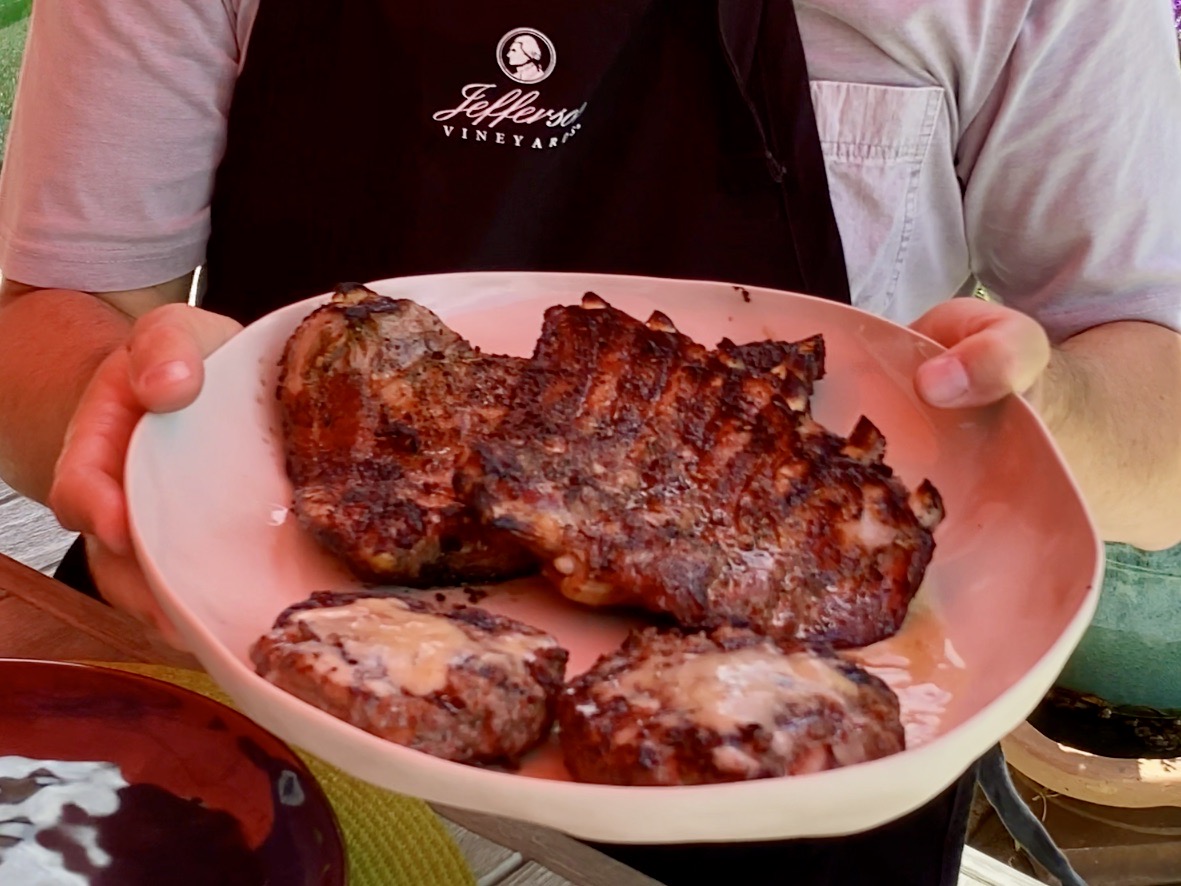
What could more aptly describe summer gatherings than a grill in full blaze and the accompanying sizzle of fresh foods charring in neat streaks? For every perfectly chilled red, there is a grilled mate to match.
From the grill, foods gather flavor – smoke, salt, and spice interwoven. Charr marks themselves present a near peppery spice - this is without accounting for what seasoning may have been added beforehand. To complement the accents provided by the grill, the best wines will give brightness that balances its smokey notes without canceling these accents completely. In this way, reds – particularly chilled reds – are a fantastic option. The dark fruit flavors that define so many reds offer a ‘just right' sort of brightness while the notes of oak, tobacco, and spice that distinguish a range of reds pick up on the grill’s spice additions. When chilled, these favors and structures are heightened while the wine’s cool temperature refreshes its consumer.
A Perfect Match: Vin Rouge
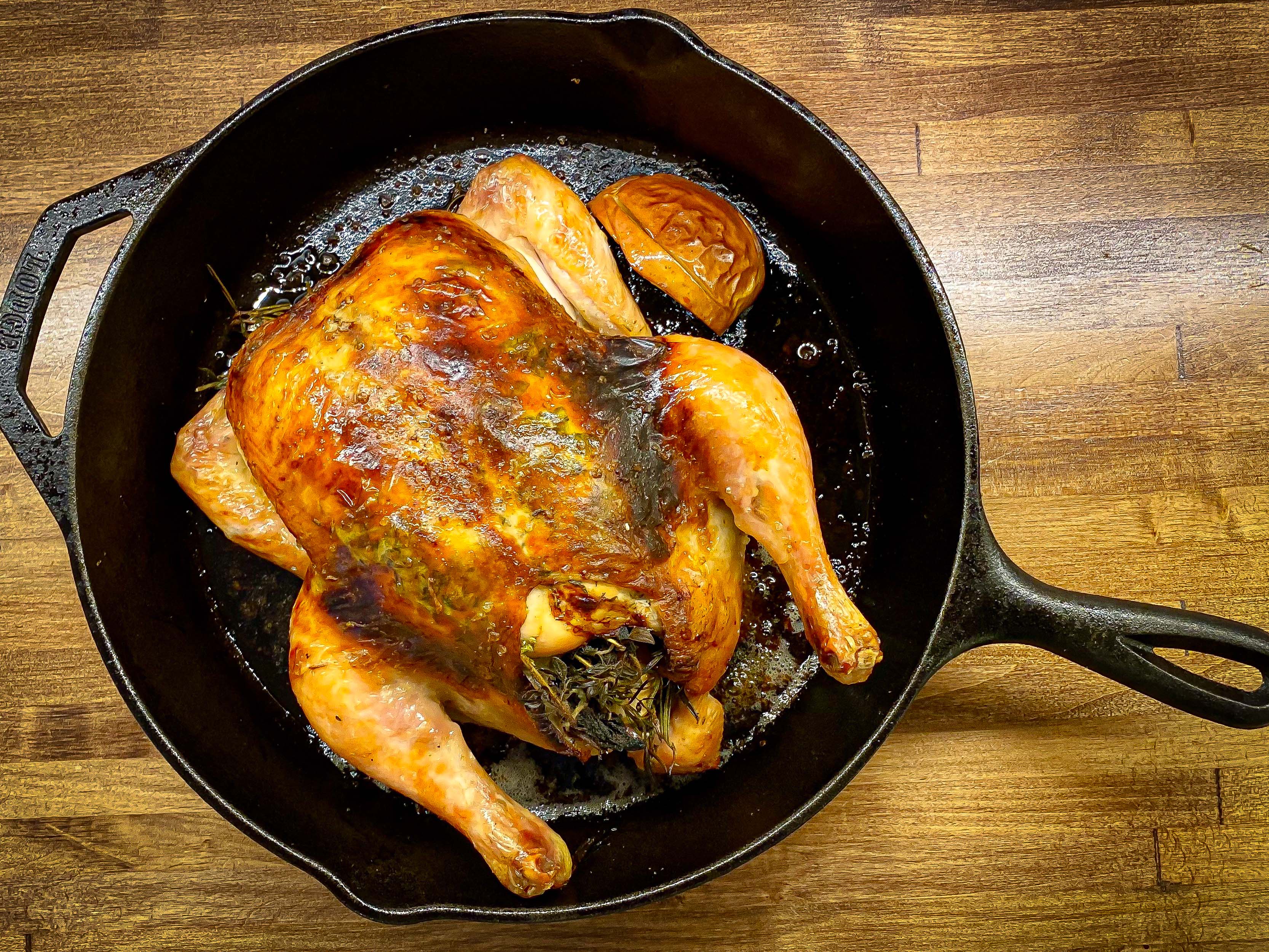
Just as the type of wine will influence the temperature to which it is best chilled, the type of meat will determine the wine with which it is best paired. As a rule of thumb, the leaner the meat, the lighter the wine. The smoke and spice components added by the grill expanded the catalog of well-suited wines. Where once a poultry dish may have best matched a white or rose style wine, when charred on the grill, a light-bodied red offers fruitiness to the dish.
A similarly light-bodied wine would be a wonderful option for the vegetarian grillers among us. A grilled portobello mushroom, perhaps, would be best complemented with a light-bodied wine whose subtle tannins won’t overpower the tender earthiness of the mushroom. Look for a wine not dissimilar to our 2019 Vin Rouge, for instance. With candied red fruit aromas, a palate bursting with red cherry flavors, and a smooth finish with soft tannins, this wine would chill beautifully. Balanced sweetness, red fruit flavors, and soft tannins contribute complimentary freshness to the grill’s savory flavors with just enough structure to cleanse the palate and accent its accompaniments.
A New Summer Staple: Meritage
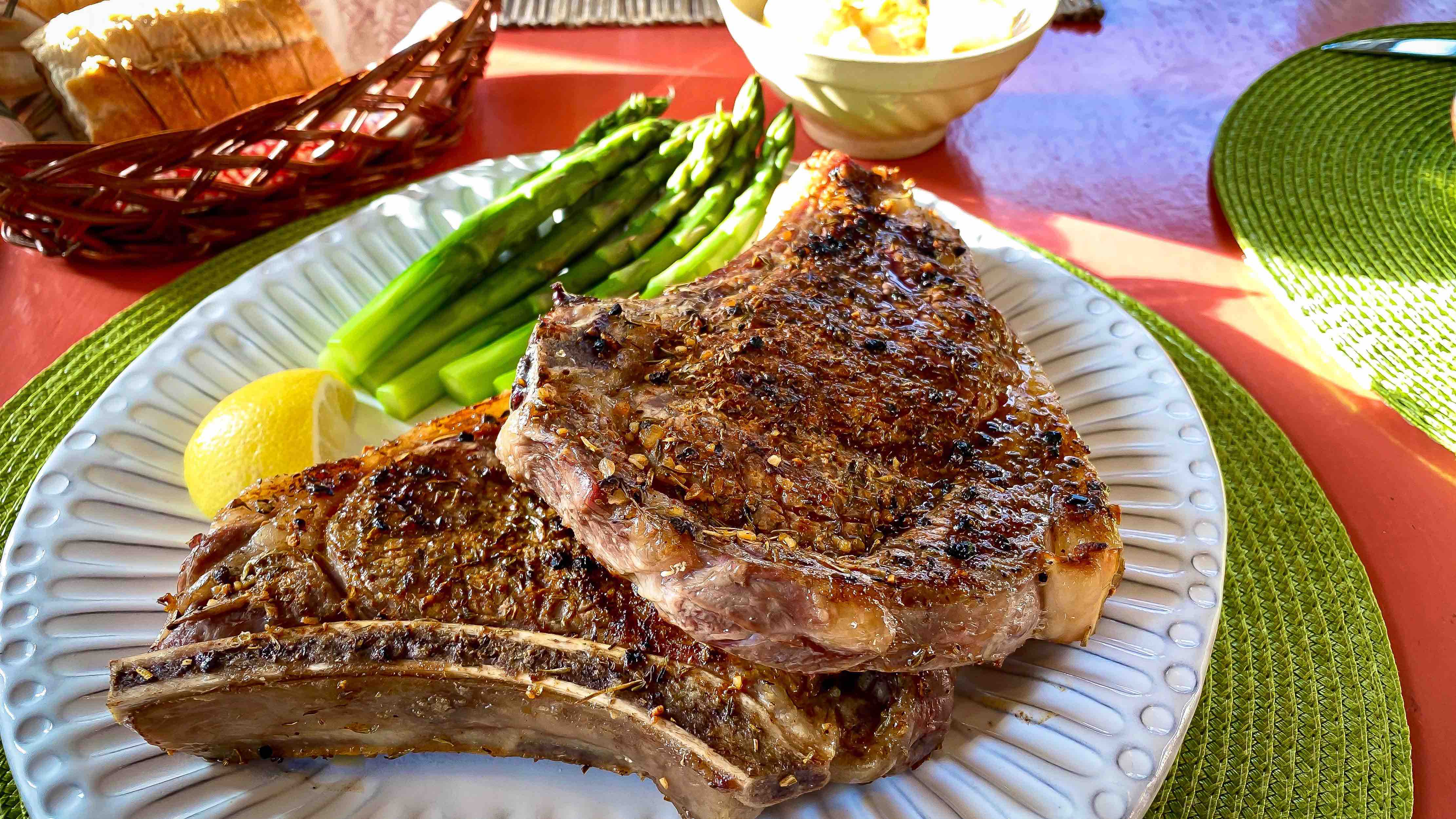
For beef and fattier meats, venture into the world of medium-bodied reds. The higher tannins of a medium-bodied wine provide structure to the wine and cuts through the fattiness of the meat and resets the palate. Better yet, medium-bodied wines with notes of spice, pepper, and tobacco amongst bright fruit flavors enhance the grills charred flavor additions. Accordingly, we recommend any number of Meritage wines.
A Bordeaux style blend, Meritage wines are well-balanced medium-bodied with intricate berry, cedar, and spice. Our 2015 Meritage for instance, opens with cedar, oak, and blackberry on the nose. On the palate, dark cherry, and berry flavors reign supreme with a bright acidity before finishing with tannins and a lingering spice. Our 2016, 2017, and 2018 vintages each distinguish themselves with slight blend and vintage variation but all are delightful to enjoy chilled and would offer structure bold enough to balance grilled steak, pork, or your favorite burger.
We've collected these, our most chill and grill-worthy reds, in this month’s Featured Wines Collection. So, put your favorite red in the fridge while you stoke the grill. Your beloved fruit-forward wine might just become a summertime staple.
June's Blooms, Butterflies & Bees
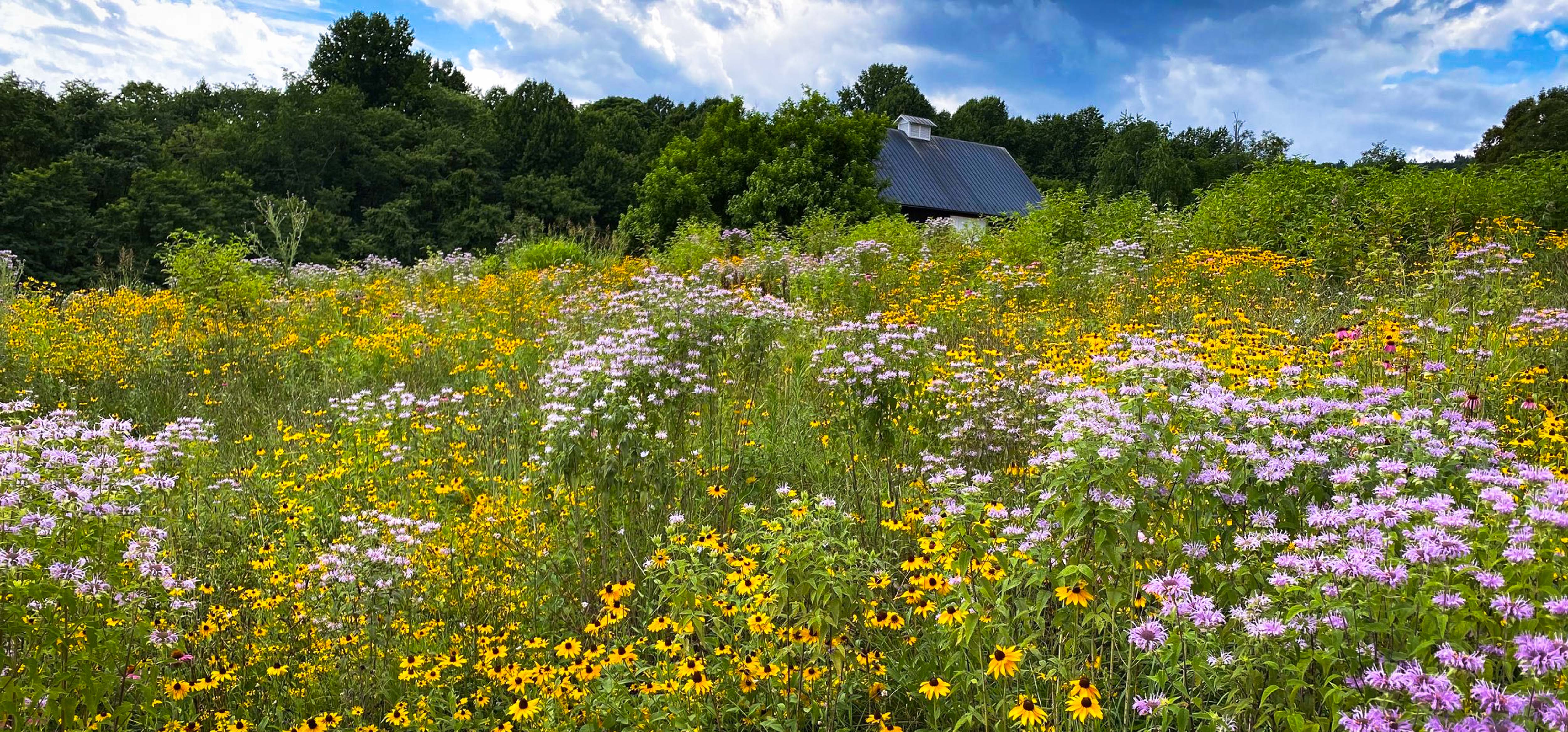
To arrive at our property this time of year is to find yourself surrounded by green: lush pastures, rolling hills, the wooded mountain, and the green rows of Pinot Gris and Chardonnay vines set against the red roof of St. Luke’s Church. All of this is visible from the acres dedicated for guests to enjoy our wine, yet this spectacular vista is a sliver of the bigger picture. Our estate stretches across 700 acres, from the forest line atop Carter’s Mountain to Jefferson’s Monticello to Monroe’s Highland home. Since our beginning we have cared deeply for this land, investing in its health and wellbeing well beyond the benefit to our vineyards.
Preserving Our Land & Water
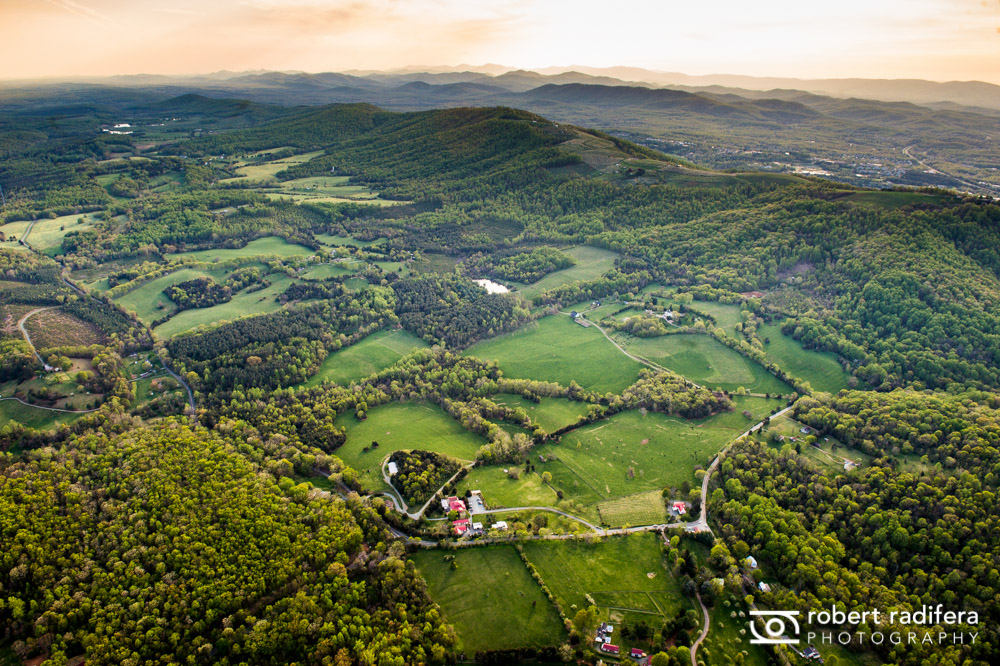
In the 1970's the first generation of Woodward owners, Shirley and Stanley Sr., placed nearly 700 acres under conservation easement in perpetuity, setting the stage for our county to have the third most land conservation in Virginia. With this act, the Woodward’s protected our land from future development and inspired others around them to do the same. Our vistas, the beauty of the natural world, and the historic corridor upon which we sit will remain as is for generations to come.
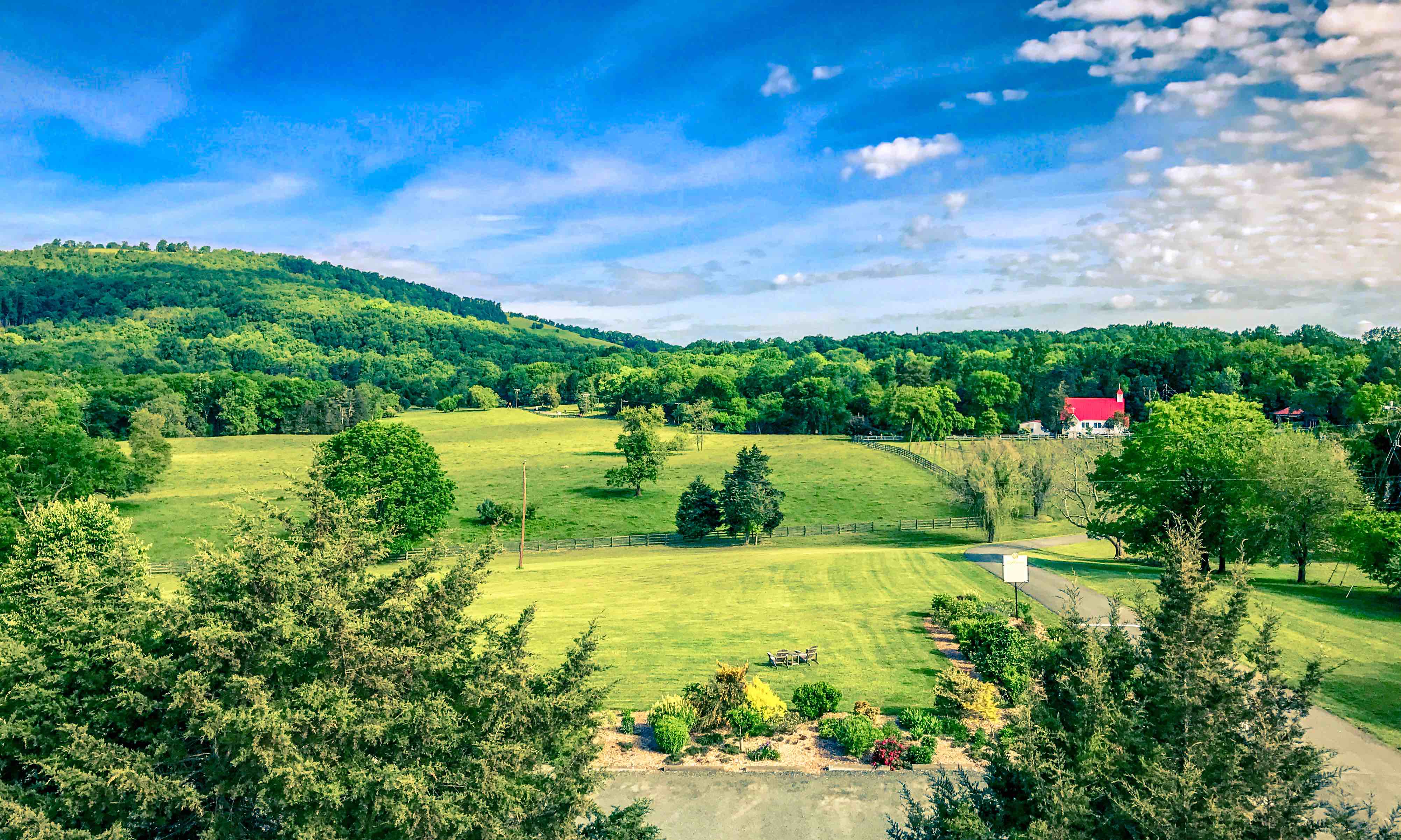
The first Woodward owners made clear their belief that this land and its resources are worth protecting. Each subsequent generation has followed in their footsteps and cared ceaselessly for the property. As we have preserved our land, we have worked to protect waterways from harmful agricultural runoff. The streams and tributaries that pass through our property eventually filter into the Chesapeake Bay, one of the largest estuaries in the United States. We protect these precious resources from our cattle operation by constructing extensive fencing at least 90 feet away from on-property waterways. Though the health of the Chesapeake has improved, we continue to do our part, reducing the impact of our cattle on our waterways as best we can. Most recently, our environmental attention has turned towards our pollinator populations.
Supporting Our Pollinators
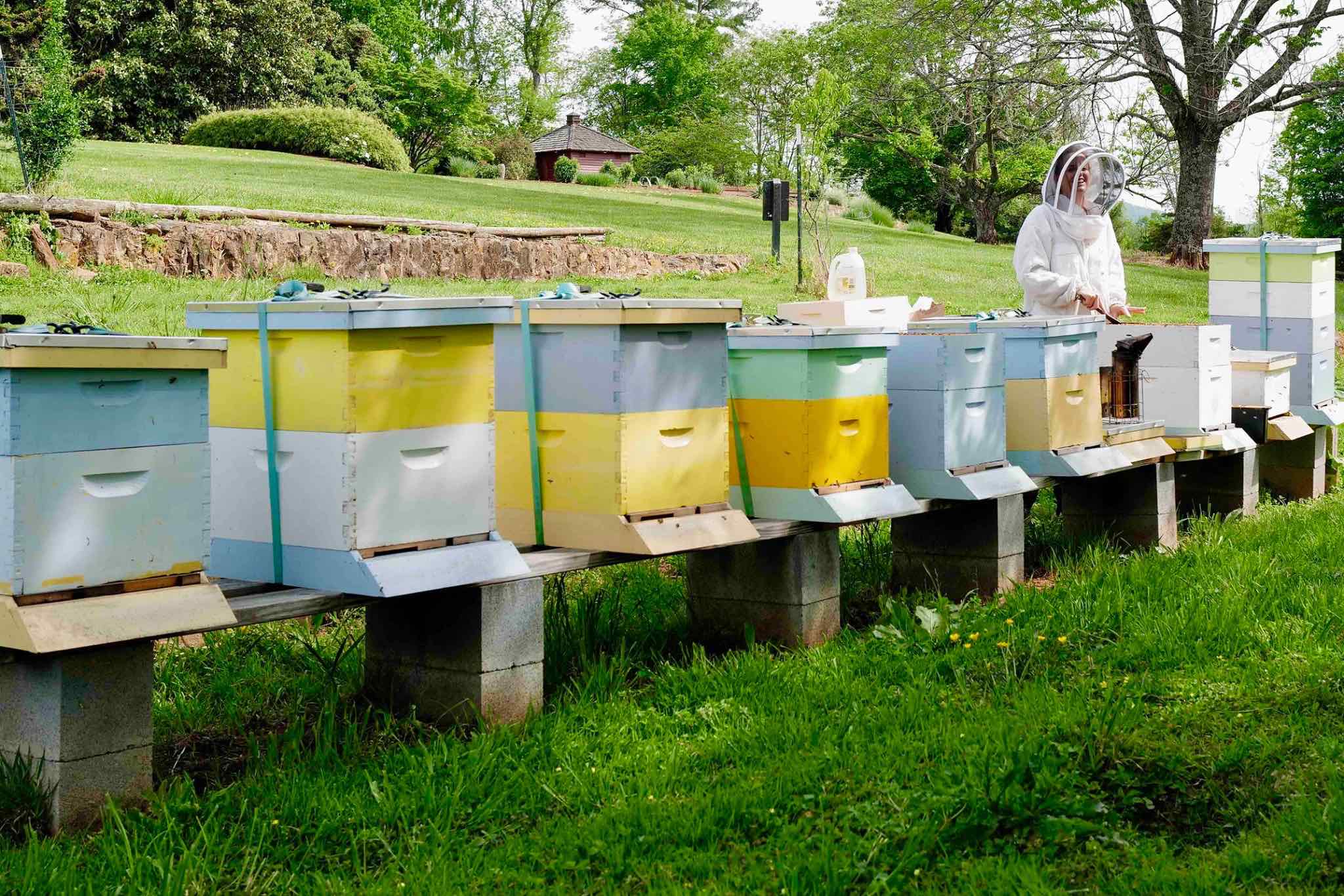
Pollinator populations have been in decline for years – 50% of honey bee hives collapse annually in the United States [1]. This population decrease is a threat not just to pollinators, but to us all. Pollination is critical to the wellbeing of ecosystems and the success of agriculture. Some experts have estimated that about one-third of every bite of food we eat exists thanks to pollinators like bees, butterflies, and other insects [2]. The predominant threat to these precious pollinators is simply the loss of healthy habitat – a problem remedied by ensuring hives are located on healthy land with robust forge and ecosystems. Accordingly, we have tried to provide a home and habitat for these critical creatures.
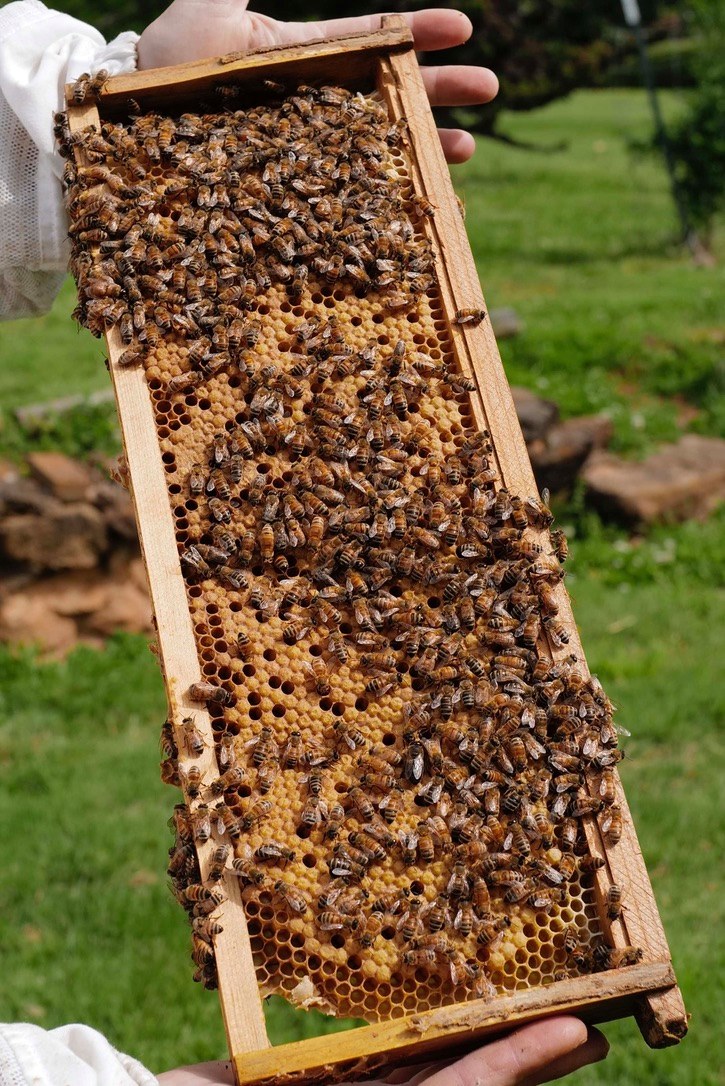
We host ten apiaries on our property to foster honey bee populations. Honey bees are a super-organism, a collective of individuals and generations working selflessly together for the survival of the whole colony. Each of these apiaries safely houses a queen bee and hundreds of thousands of bees, giving them space in which to build their hives and bolster their populations. Beyond a safe haven, we have transformed acres of our property to provide ideal food and habitat. Seven of our acres are now dedicated wildflower meadows. Spread between three distinct plots on our 700 acre property, these meadows are filled with native wildflowers.
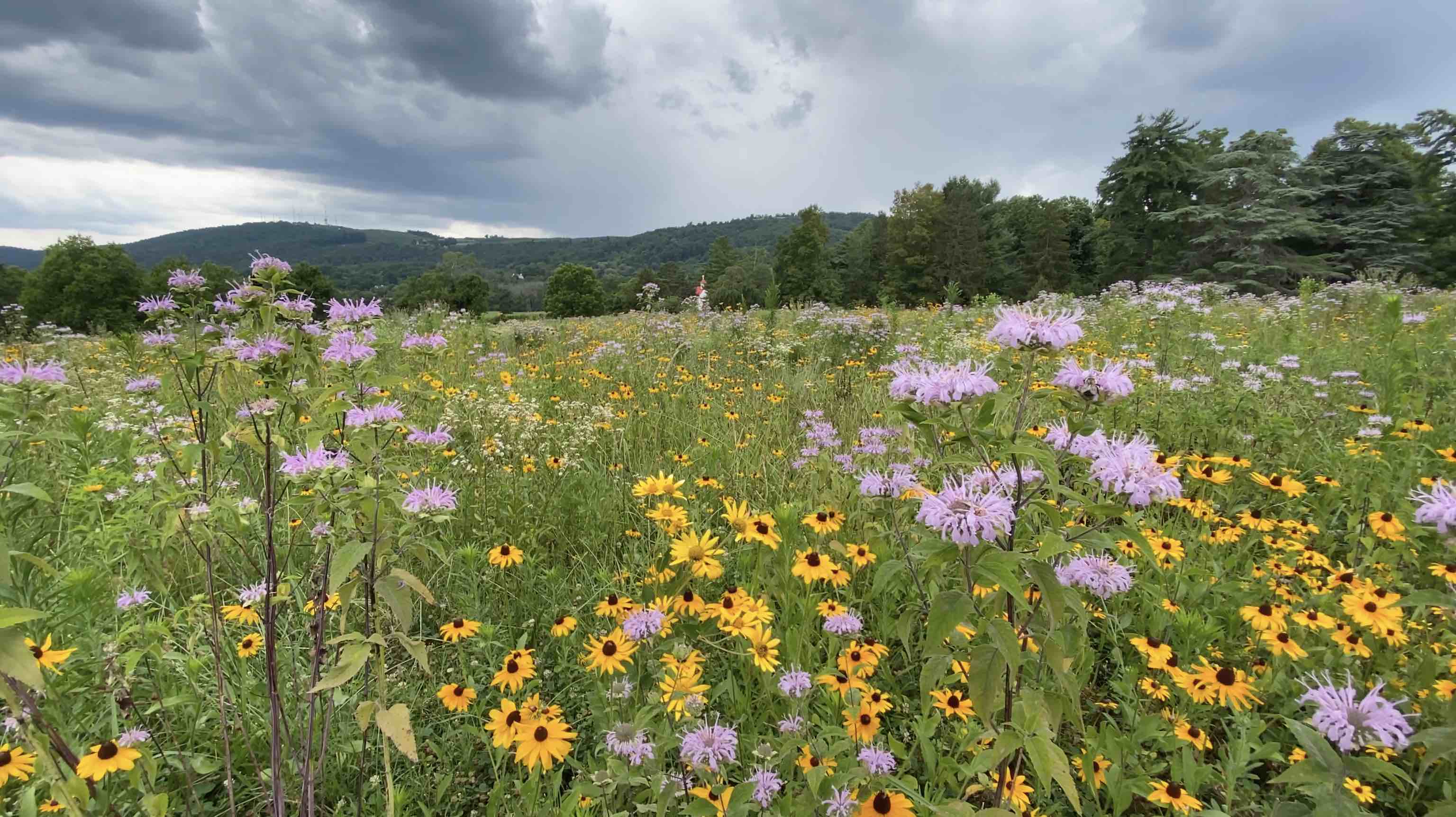
Additionally, in March of 2020, we planted 12,500 Tulip Poplar Trees to bolster critical ecosystem diversity. Unfortunately, many native trees in our area have been replaced by Loblolly Pines as a source of timber. By planting Tulip Poplar trees, we repopulate our land with one of Virginia’s largest native tree species. Adult Poplar trees bloom in vibrant color; their large flowers are a near-neon yellow with a halo of orange around its base. Jefferson himself described the Tulip Poplar as “The Juno of our Groves" and planted one at Monticello [3].
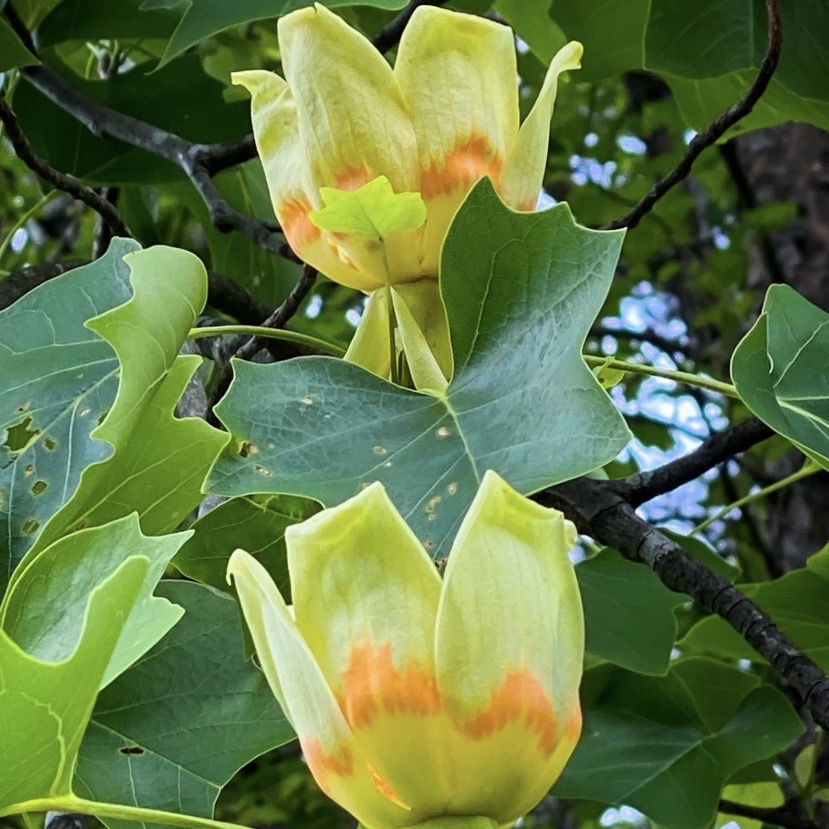 Upon returning their hives after visiting these floral oases, our bees transform the collected pollen into honey. The honey serves as food for the bees to help them survive the winter. We harvest any extra honey as a partner farm of the Elysium Honey Company. Elysium Honey is a local organization dedicated to caring properly for local pollinator populations and sharing the amazing, unaltered honey that comes from these hives. We provide the utmost care for our bees and are thrilled to soon share our first ever, 100% estate honey.
Upon returning their hives after visiting these floral oases, our bees transform the collected pollen into honey. The honey serves as food for the bees to help them survive the winter. We harvest any extra honey as a partner farm of the Elysium Honey Company. Elysium Honey is a local organization dedicated to caring properly for local pollinator populations and sharing the amazing, unaltered honey that comes from these hives. We provide the utmost care for our bees and are thrilled to soon share our first ever, 100% estate honey.
The Gardens You See
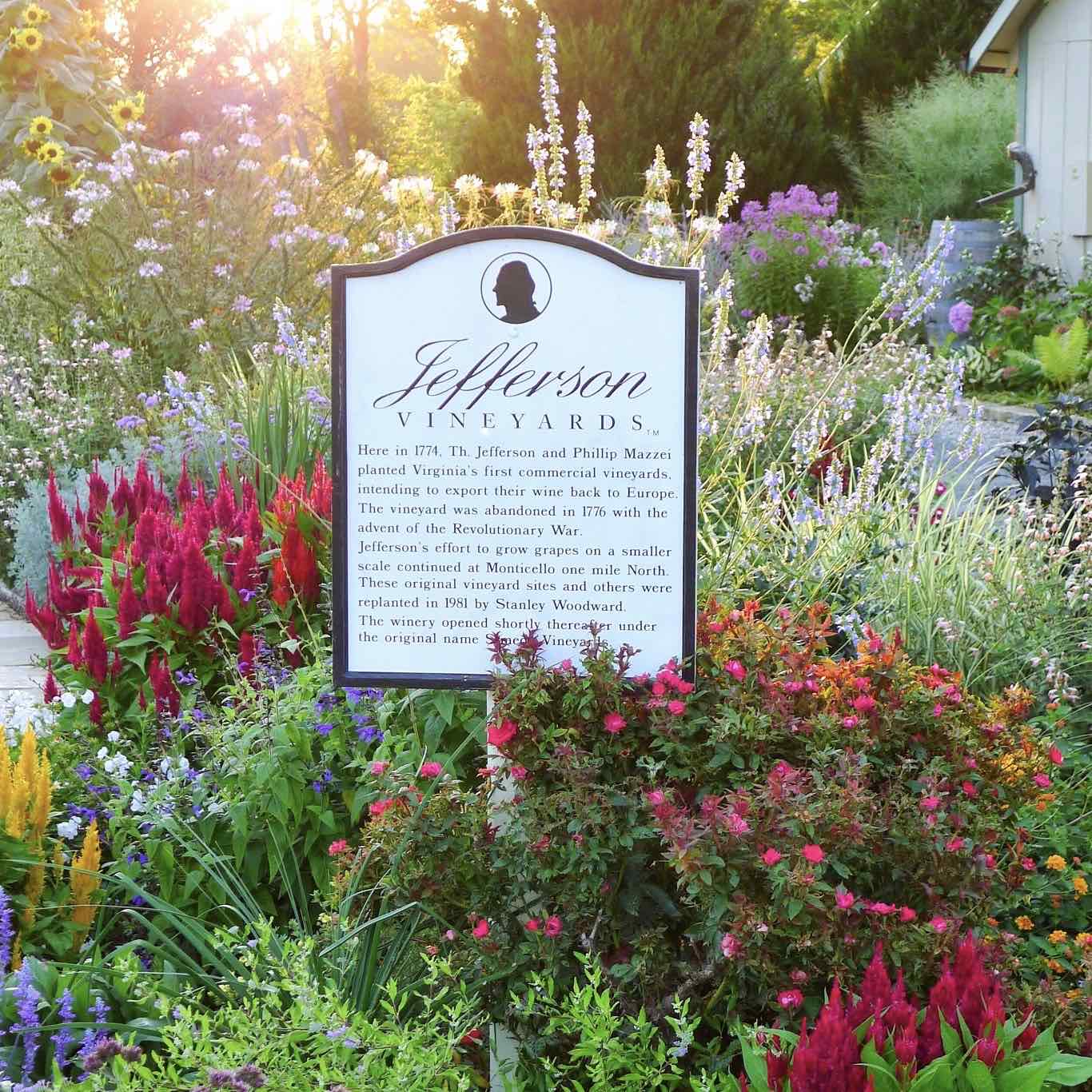
Arriving on our property, you will find yourself surrounded by a sea of lush green in the midst of which bursts our brightly colored English Gardens. Bordering our patio, this Cottage Garden was designed to bloom eight months of the year, attracting butterflies, bees, and more beneficial insects into this ecosystem. These gardens remind us of all that is precious and beautiful about our land, and Virginia. So, as you enjoy your wine in view of the garden’s spectacular color think of the Tulip Poplars and wildflower meadows tucked out of sight, know the water that filters through our grounds is being cared for, as are the honeybees that float amongst the flowers.
To further welcome the end of Spring, we’ve selected wines that best reflect this spectacular season, each fruit-forward and full of floral notes. The Traminette 2019 is our most floral wine, with rose, easter lily and pear on the nose – a bouquet reminiscent of exotic perfume. Our Riesling too greets you with notes of lavender while each of our rosé wines boast berry notes and are themselves a burst of color as bright as Spring. Find each in our Limited Release Shop.
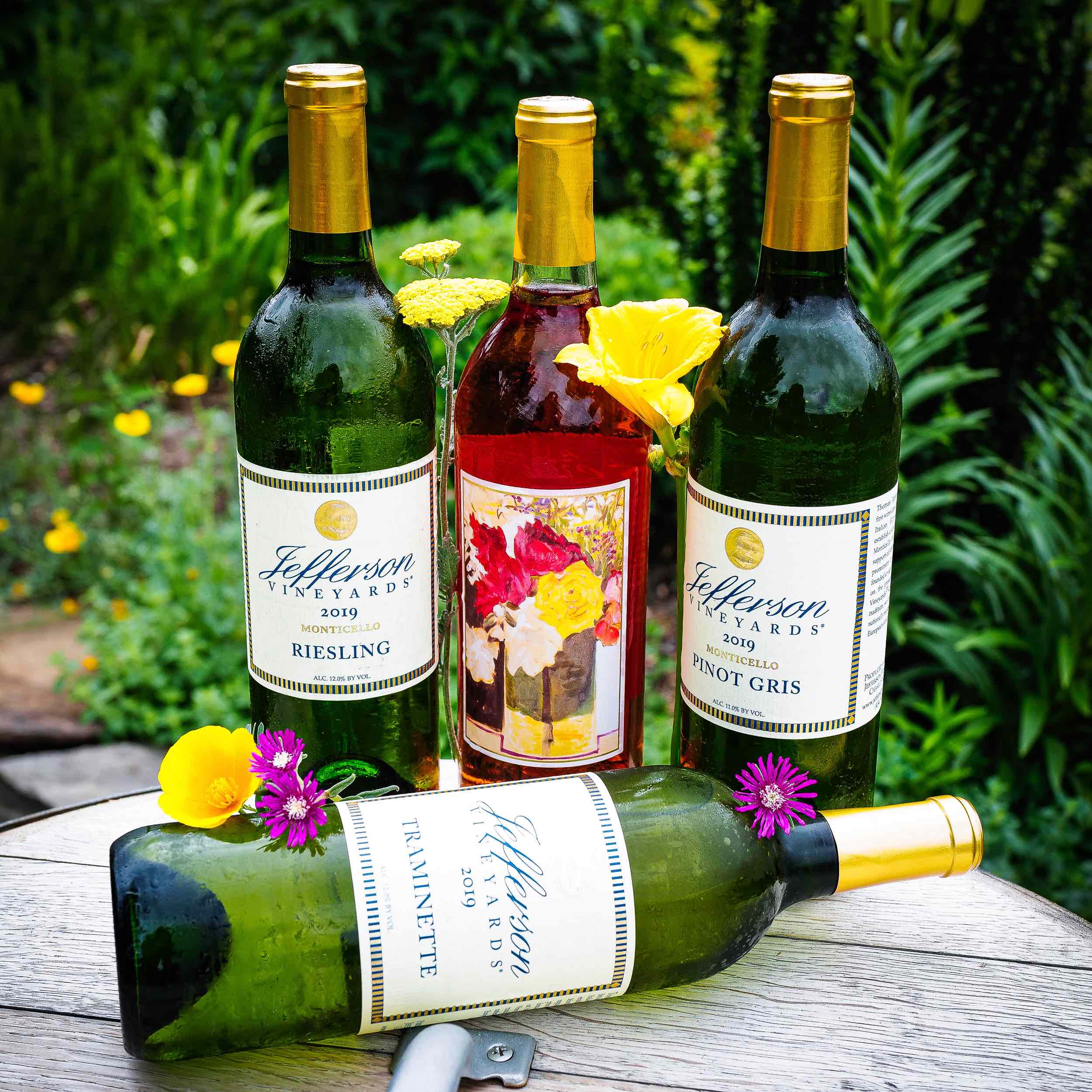
[1] “The Elysium Honey Co.” The Elysium Honey Company, www.elysiumhoney.com/.
[2] “Natural Resources Conservation Service - Insects and Pollinators.” NRCS, USDA , www.nrcs.usda.gov/wps/portal/nrcs/main/national/plantsanimals/pollinate/.
[3] “Tulip Poplar - Liriodendron Tulipifera.” Monticello, The Thomas Jefferson Foundation, www.monticello.org/house-gardens/in-bloom-at-monticello/tulip-poplar/.
The Secret to Our Viognier
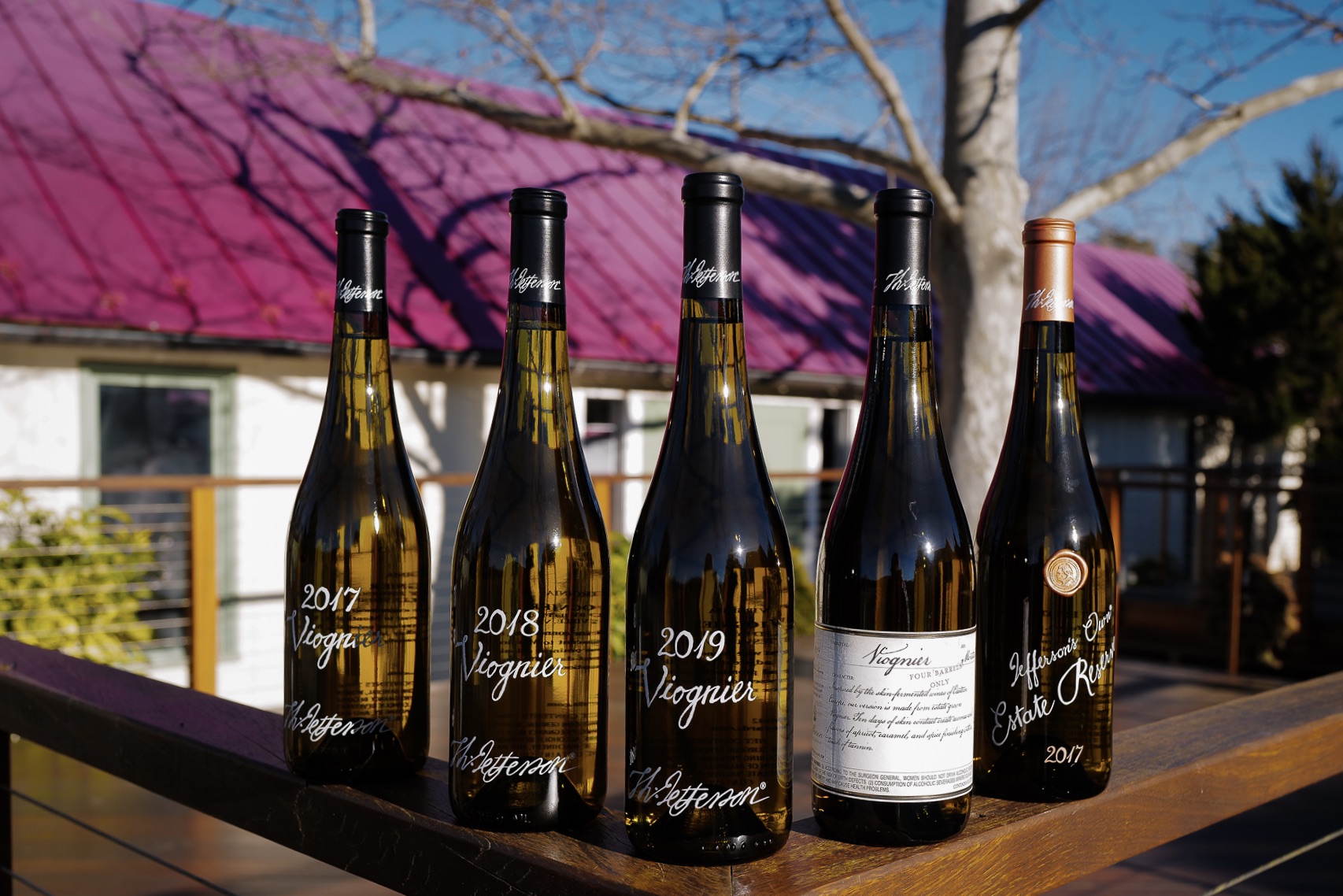
Peach, apricot, and lychee on the nose, a delicately balanced palate precede a round and lengthy finish. This is our golden-toned Viognier. Pronounced "vee-ON-yay", this French grape has found a home as the state grape of Virginia. Crafted from vines cared for by hand, aged for months, and created with the artisan expertise of our winemaking team, it is Jefferson Vineyard's flagship white, our most consistently awarded wine.
With decades of Viognier production and accolades, we're ready to share the secret behind this delicious white wine. Curious to learn more? Read on.
In the Vineyards
We designate nearly a quarter of our twenty-two planted acres to Viognier grapes. These fickle grapes are challenging to grow, but for us, the risk is well worth the reward. These bright green grapes flourish with strong sun and heat and more water than other varietals; a perfect complement to Virginia rains and summers. For over a decade, Hector and Nora Guzman, with the help of their family, have cared for these vines.
Though labor-intensive, the Guzmans prune, hedge, and pick the fruit by hand, ensuring each bud, shoot and grape receive personal attention. Viognier in particular cannot compete with other growth - be it grass or weeds - and must be tended to accordingly. Shoots that grow laterally instead of horizontally (known as ‘lateral shoots’) are corrected. Hector and his family keep watch for the early signs of pests or disease, meticulously maintaining our vineyards' health. And when the end of August rolls around, they harvest only the healthiest and most robust of fruit.
In the Winery
Great wine cannot be made without great fruit and of course, great winemakers. Chris Ritzcovan, our winemaker, and David Woodside, our assistant winemaker, have been working together in our winery for nine years. Throughout their tenure, the two have approached production with a steady commitment to both quality and creativity.
Before our Viognier is harvested, our team tests the fruit for particular sugar levels that will bring forth the apricot or peach flavors and floral aromas that epitomize the viognier varietal. Once in the winery, they begin the stylistic processes that distinguish our viognier. They inoculate the wine with commercial yeast, ferment it in oak barrels and stir the barrels on their lees to build the body and weight you sense in a sip of our final product.
To age the Viognier, again consideration is given to the precise barrel type. On the wine, their selection gives way to a toasted influence, carefully curated to complement the fruit and structure of Viognier.
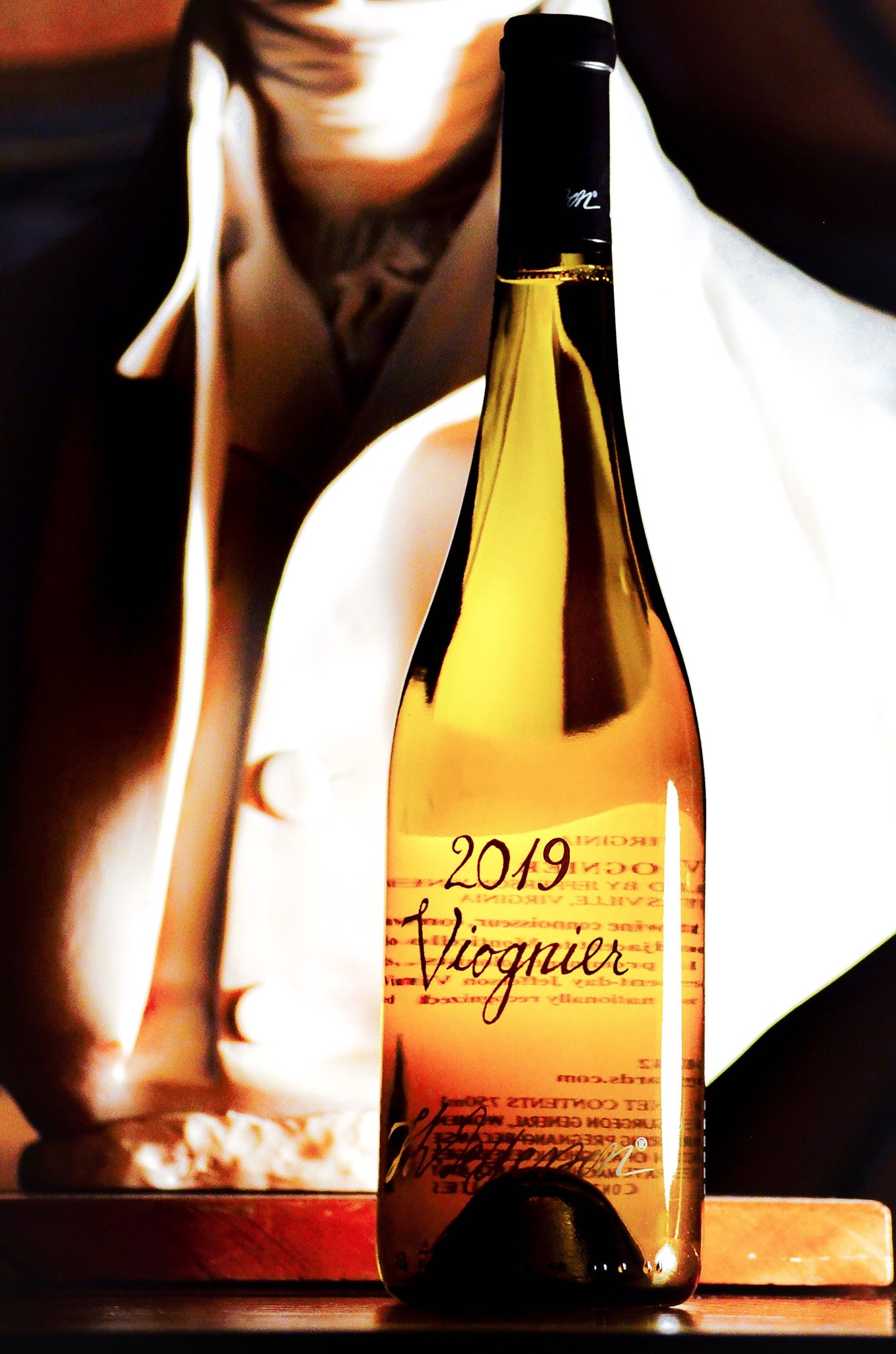
In the Glass
Nearly eight months after the fruit is picked, our Viognier is bottled and shared through our tasting room. It is championed by people like Heather Lavelle, our Retail Operations Manager, who will tell you our Viognier, though different from those of other regions, is consistent. Attila Woodward, our owner, will tell you he fell in love with Viognier because it is so beautifully balanced and pairs wonderfully with the South East Asian cuisine he spent over a decade enjoying while living in Vietnam. Both work to share their passion for this wine, submitting it to competitions across the country and encouraging those who visit us to try it for themselves.
In the 2020 San Francisco International Wine Competition, our Viognier 2019 received a Double Gold award, judged amongst thousands of other wines. Vinepair dubbed this same vintage one of the 28 Best White Wines for 2021. Savor Virginia Magazine Reader's Choice 2021 honored it with a Gold. Most recently, our Viognier was awarded a Gold by the 2020 Virginia Governor's Cup.
So, what is the secret to our Viognier?
It is the passion and dedication of the people who care for the vineyards, who craft the wine, and who advocate for its place among the top wines in the world. With every award, we are proud to advance the reputation of Virginian wine, with Virginia's own state grape.
Petit Verdot: Savor Something Special
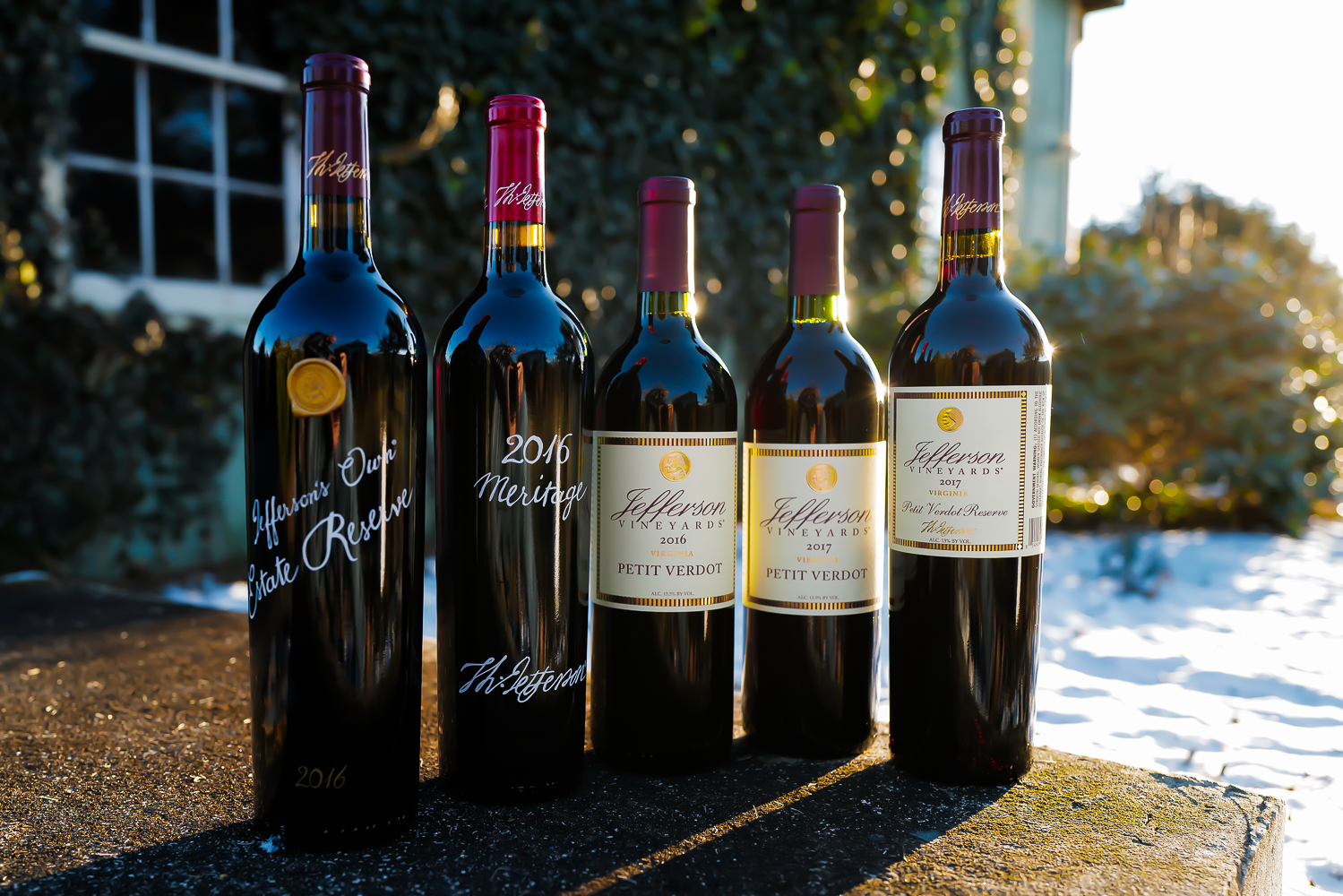
February, the last full month of winter. We face a mere handful of weeks until we can at last trust that the sun will shine. As we at Jefferson Vineyards approach our anniversary in the spring, there seems a no better time to move slowly, honey slow, and delight in the joys of these past forty years.
Valentine's Day in particular seems the day to celebrate all that we love. We of course will be celebrating our wines. Though there have been trials and tribulations over the years, none could undermine the beauty of watching our wines develop, the richness of each nuance unfolding in the glass. To savor this special time, we're filling our glasses with a bold and intricate red - Petit Verdot.
Now a darling of Virginia, Petit Verdot was known first as a blending grape from Bordeaux. We’ve loved this varietal from our beginning, grafting it as early as 1984 and bottling it in 2001 - making us one of the first in Virginia to do so.
If Viognier is the star of our white wines, Petit Verdot is our headlining red. To this day, you'll recognize Petit Verdot as a principal part of our portfolio. With it, we produce three wines: an Estate Reserve, a single varietal, and a reserve single varietal. Our Estate Reserve is not always made singularly from Petit Verdot, but when our estate's Petit Verdot fruit is undeniably perfect we cannot help but make an Estate Reserve to treasure this complex red. Our Meritage wines too manifest our adoration. Petit Verdot plays a uniquely prominent role in our Meritage program, frequently comprising the largest percentage of the blend, a blend distinct to Jefferson Vineyards.
Petit Verdot bursts with red fruit and offers a bright, balanced palate. Each iteration gives way to unique delicacies, the gems of which we've curated in our February Limited Release. Our 2017 vintage opens with caramel aromas that lead to blackberry and coffee flavors. The 2017 Petit Verdot Reserve is vibrant and oak-driven, offering plum and raisin flavors before finishing with tart cherry notes. Even our 2016 Estate Reserve (100% Petit Verdot), is distinct in its powerful spice and fig bouquet, plum on the palate, and notes of cedar in the finish.
Bold and tannic, Petit Verdot pairs equally well with red meats as it does with chocolate sweets. Should you find yourself searching for something more to savor in this final winter push, explore an iteration of Petit Verdot in our February Limited Release and delight in its details. Or perhaps you wish instead to relish in the process of taking your sweet time. For you, we've collected a decadent chocolate recipe from our beloved associate, Grandma Bond.
This February, we suggest you move slowly, make something, celebrating something, and savor something special.
Grandma Bond's Frosted Petit Verdot Brownies
For the Brownies
- 1 cup flour
- 2/3 cup unsweetened high-grade organic cocoa powder
- 1/2 tsp baking powder
- 1/2 tsp salt
- 3/4 cup unsalted butter melted
- 1/4 cup Jefferson Vineyards Petit Verdot
- 1 1/2 cup sugar
- 3 eggs at room temperature
For the Frosting (Optional)
- 1 cup unsalted butter, softened
- 3 1/2 - 4 cups powdered sugar
- 1/2 cup dry red wine
- 2 Tbs granulated sugar
Instructions for the Brownies
- Preheat the oven to 350°F. Spray a 9-inch baking pan with nonstick cooking spray.
- In a medium bowl, which together flour, cocoa powder, baking powder, and salt.
- Melt the butter in a medium bowl in the microwave for 30-second increments until the butter is fully melted. Whisk in sugar and Petit Verdot. Whisk in the eggs, one at a time.
- Fold the dry ingredients into the wet ingredients until fully mixed. Pour batter into the previously prepared pan. Bake for 25 - 30 minutes or until a toothpick can be inserted in the center of the brownies and come out dry with only a few crumbs.
- Allow brownies to cool completely.
Instructions for the Frosting
- Add the dry red wine and sugar to a small saucepan, stirring until the sugar is completely dissolved.
- Bring the mixture to a simmer, stirring occasionally. Continue simmering until reduced and is a syrup, thick enough to coat the back of a spoon. (You'll know its ready when stirring starts to form fleeting lines in the mixture, showing the bottom of the pan)
- Remove the skillet from heat; it should yield several tablespoons of syrup.
- With a standing mixer, cream together the powdered sugar and butter until whipped and fluffy. Set to a lower mixing speed and slowly pour in the red wine syrup, mixing until evenly combined.
- Fit your desired tip onto a piping bag and scoop the frosting in. You can also use a plastic baggy with one of the corners cut off.
- Generously frost each of the brownies. Serve and enjoy!

